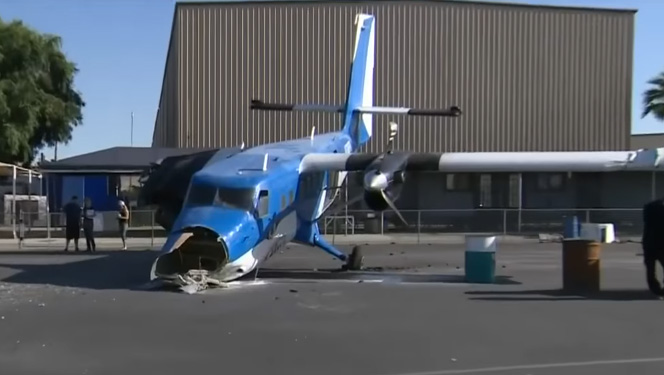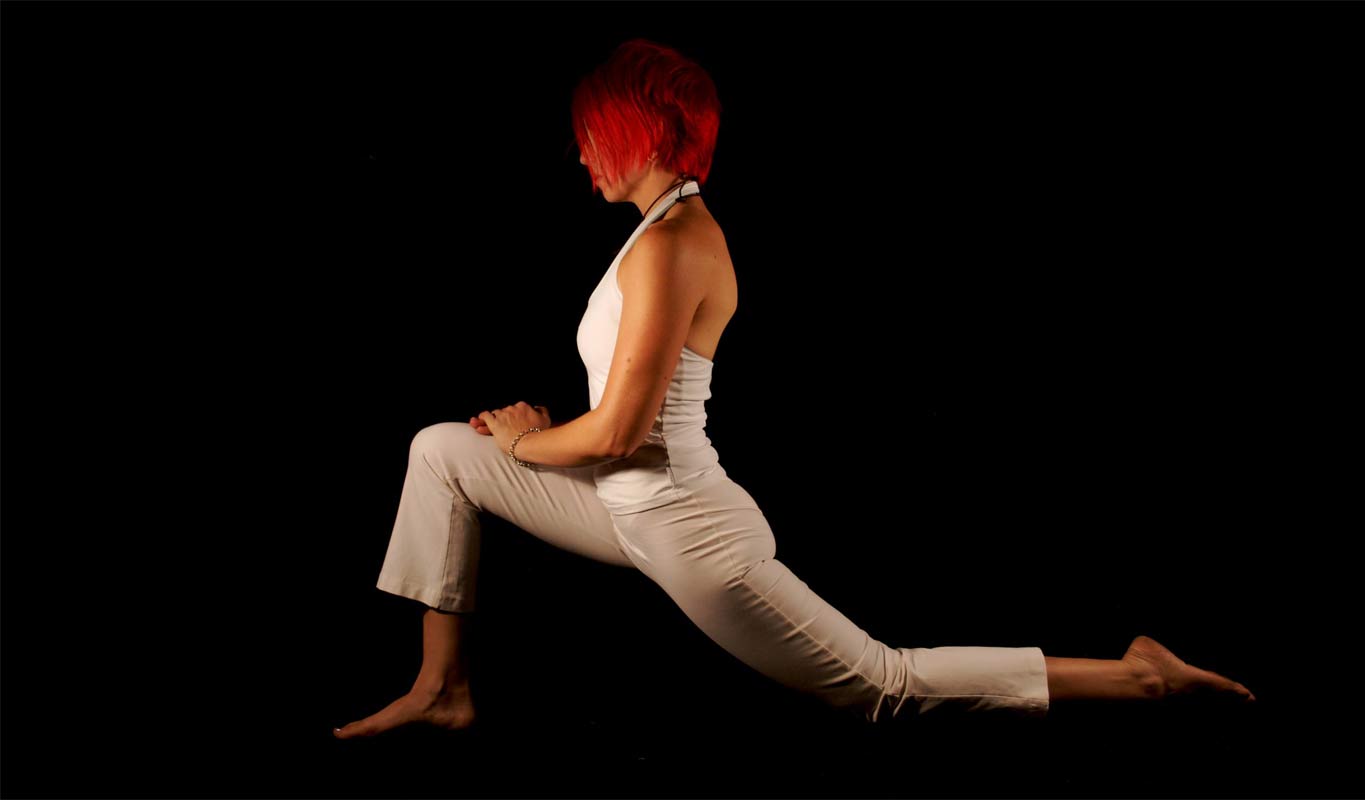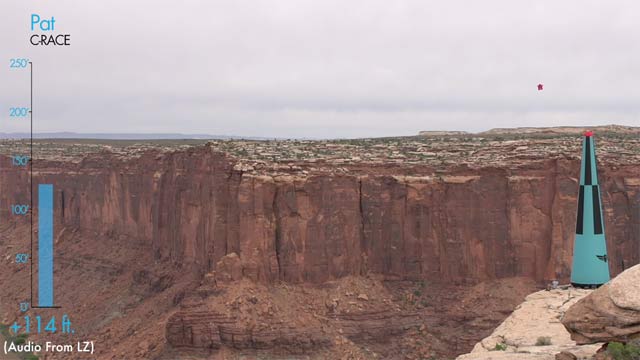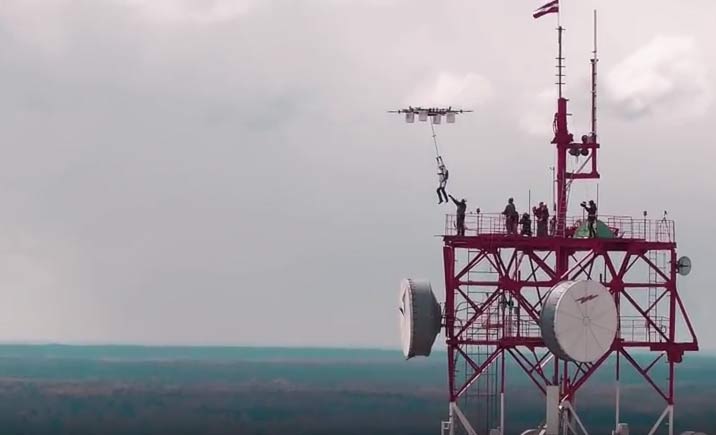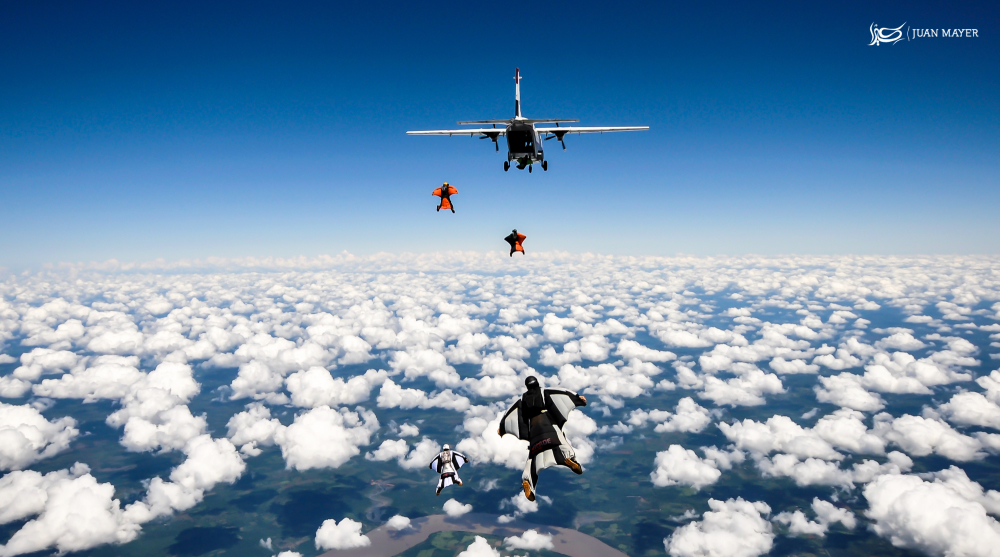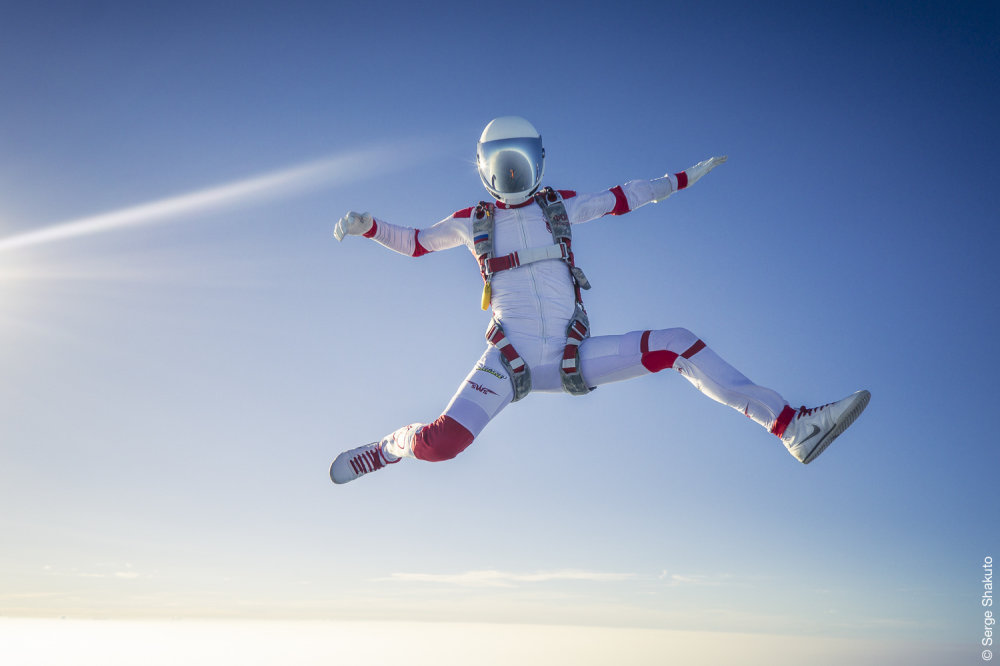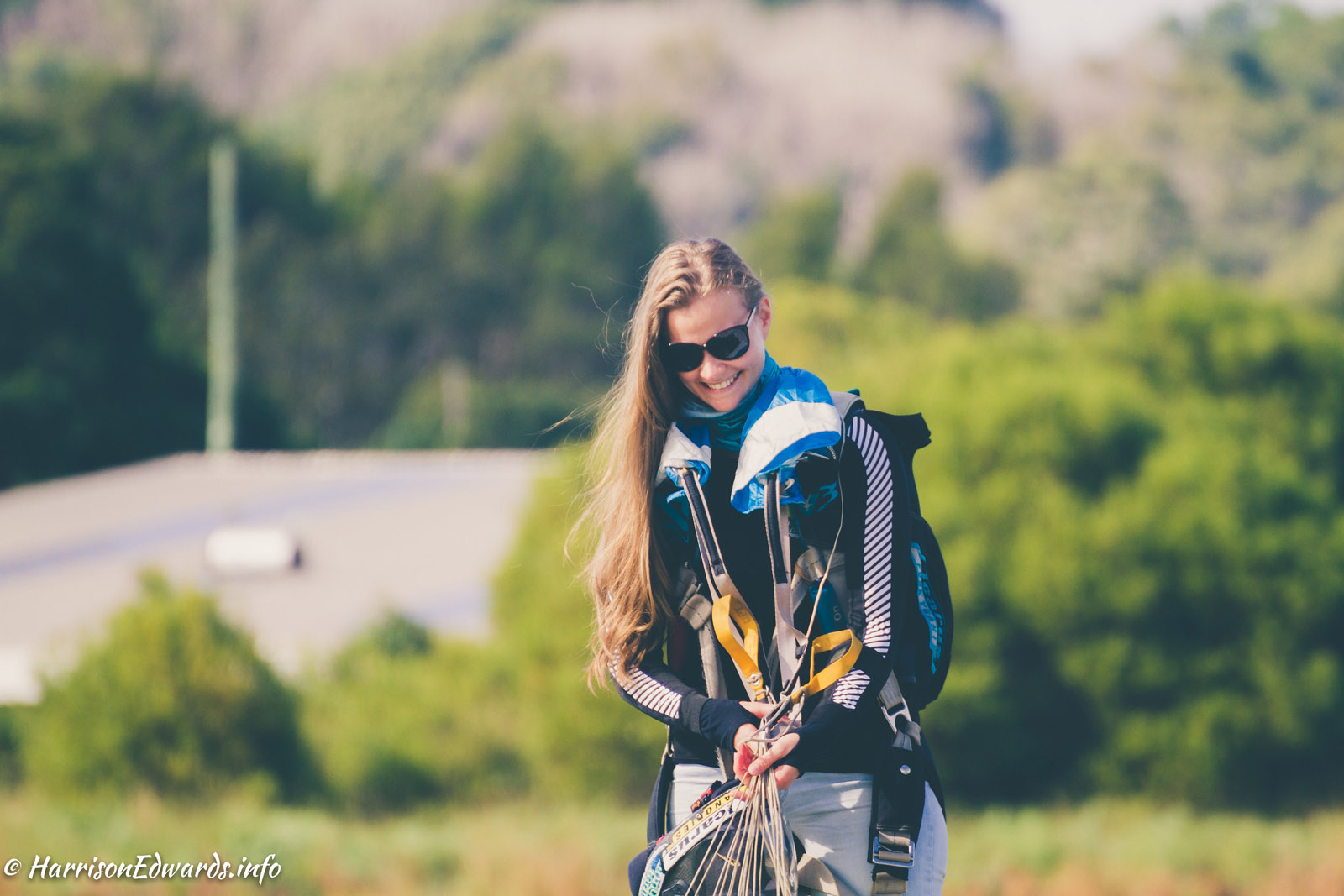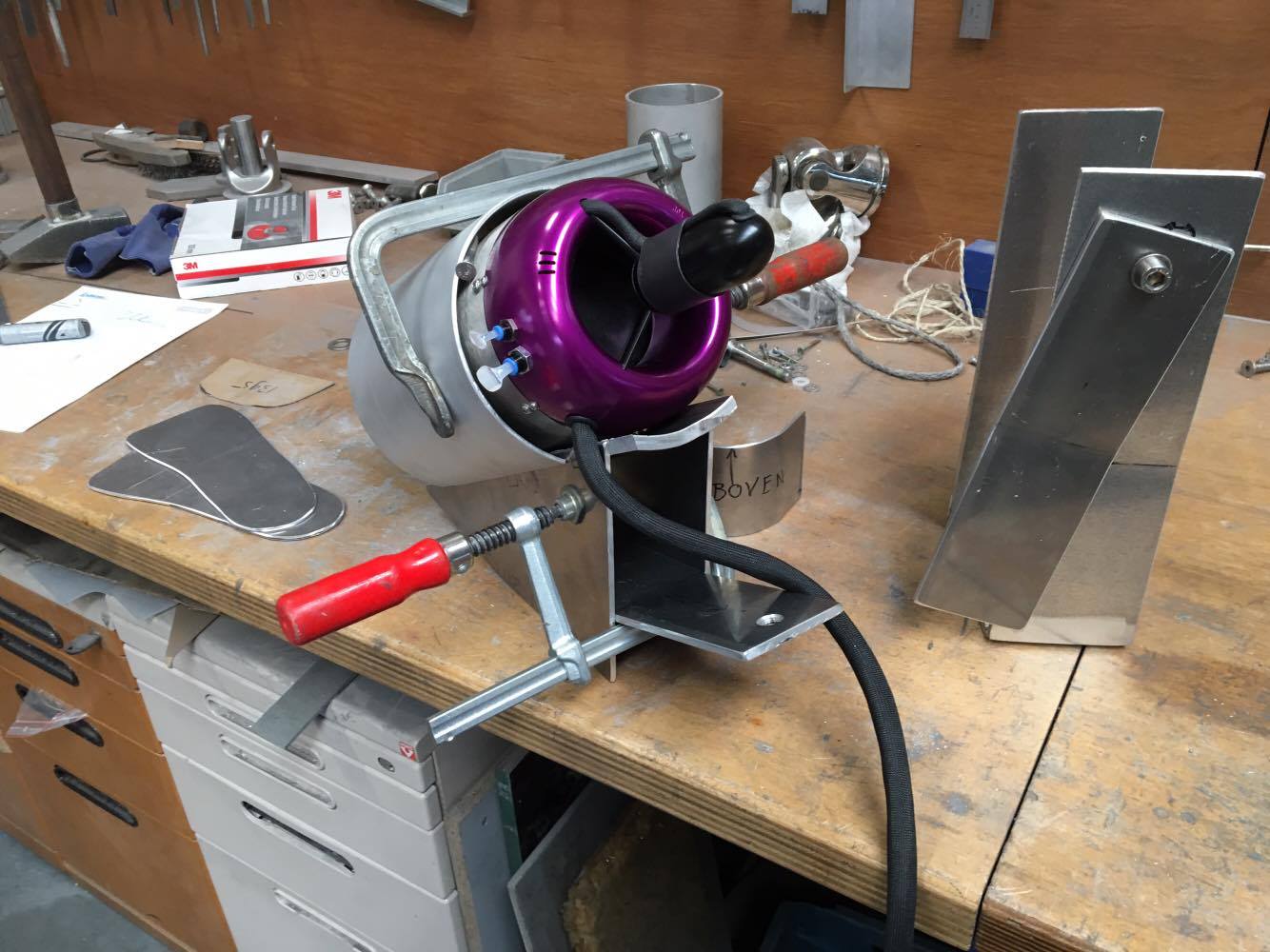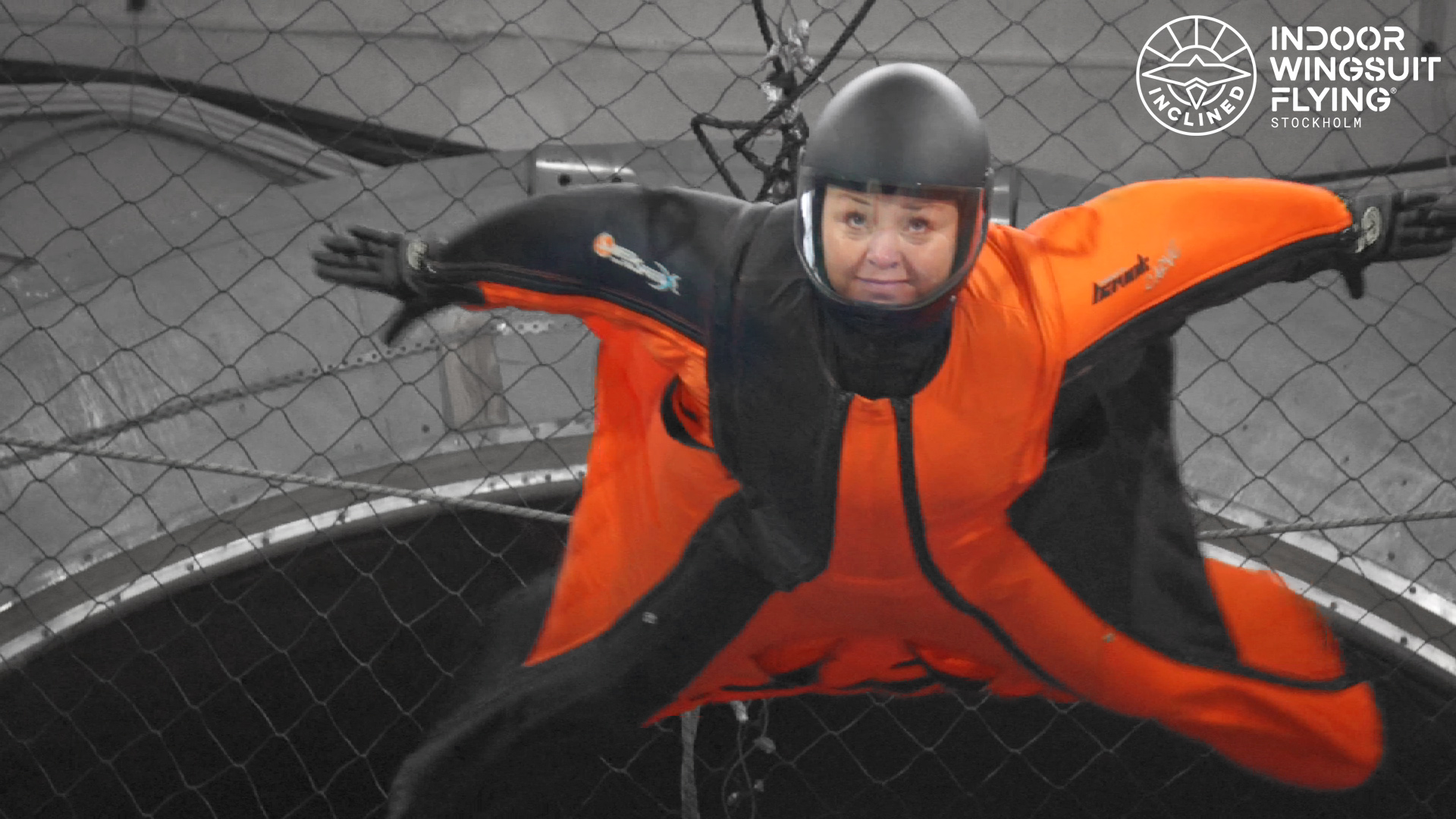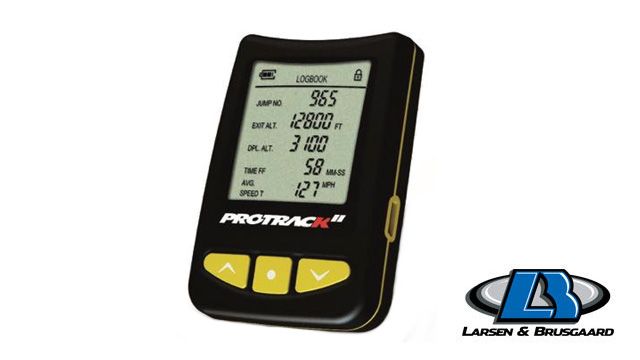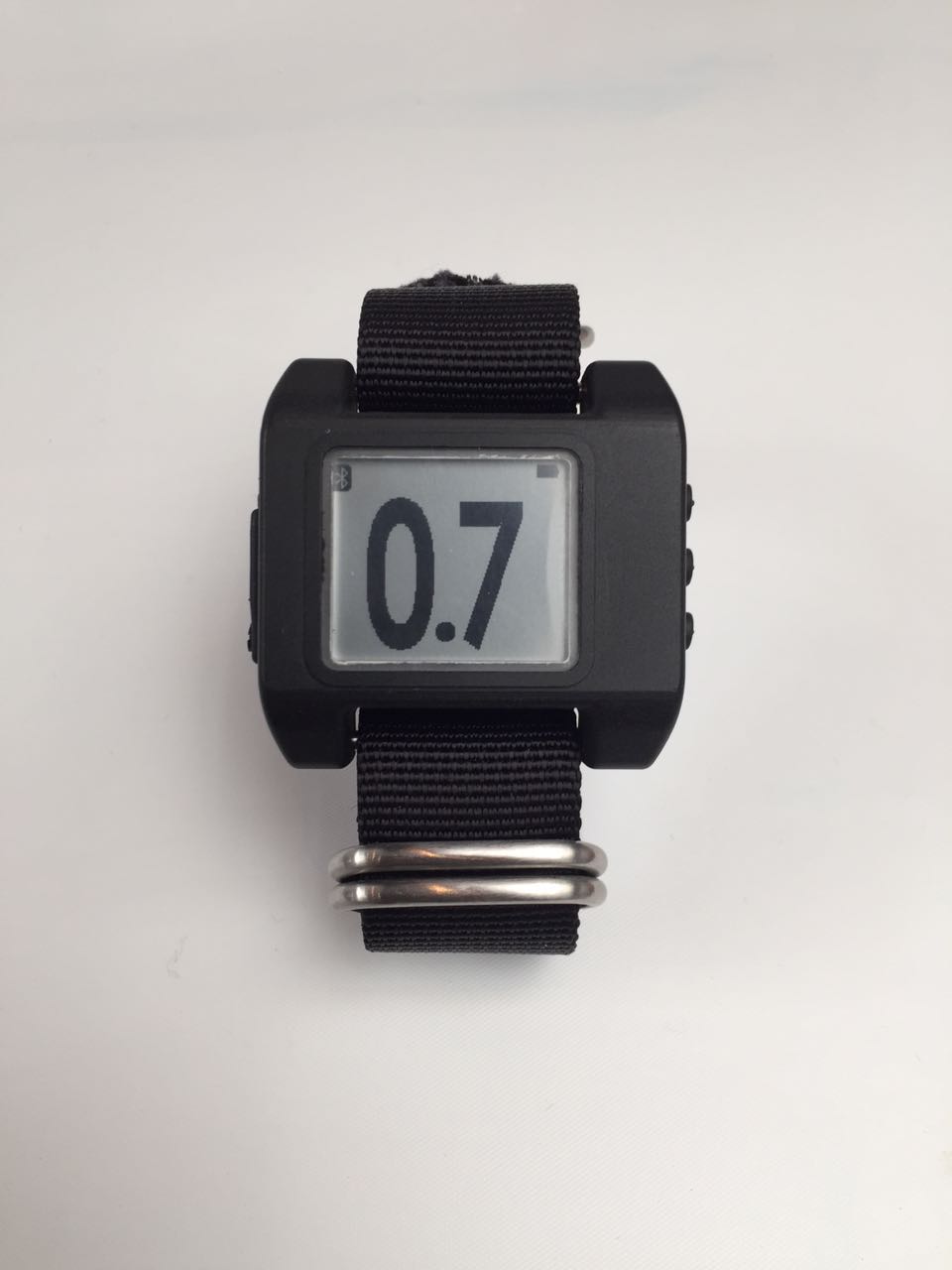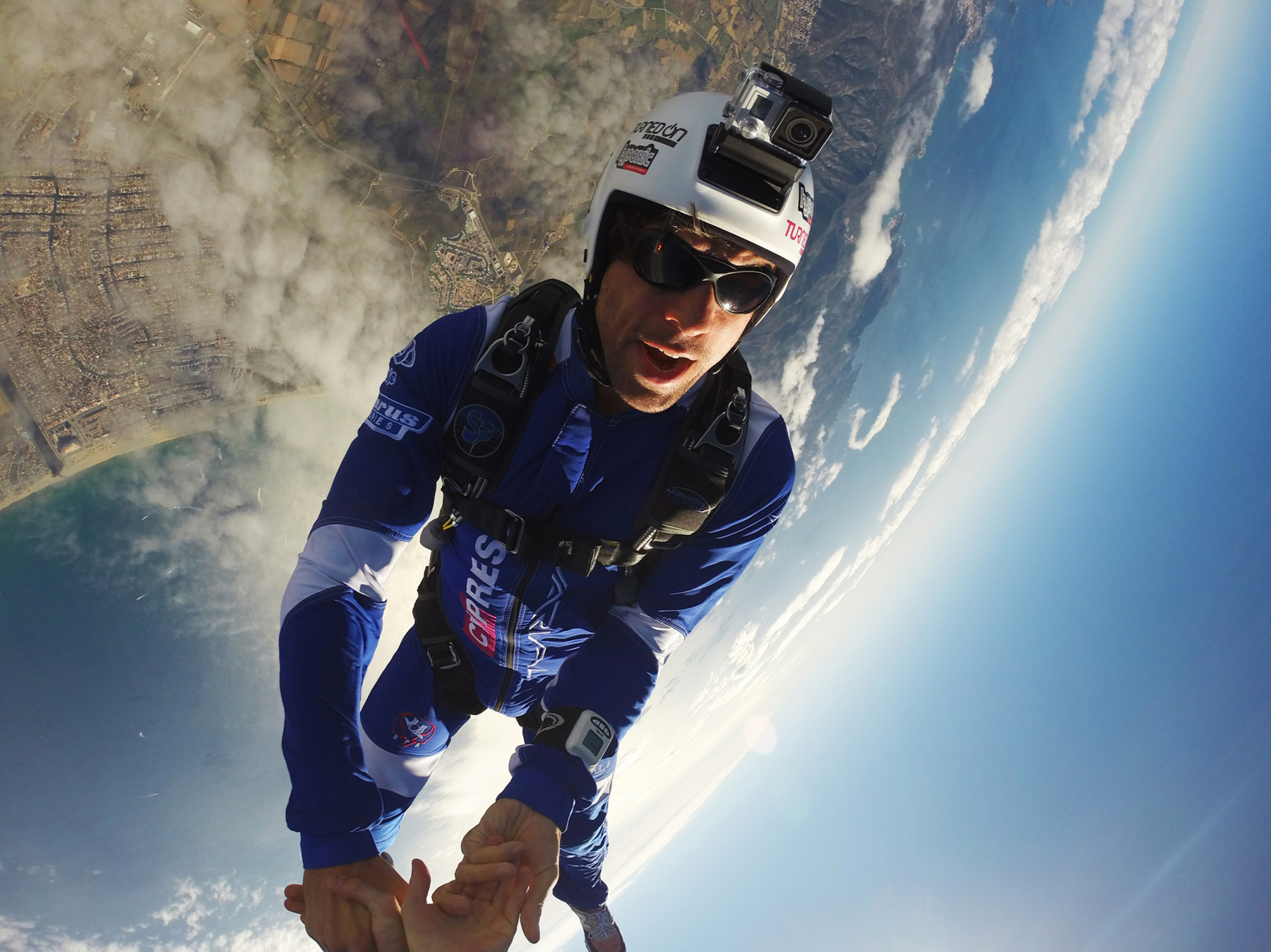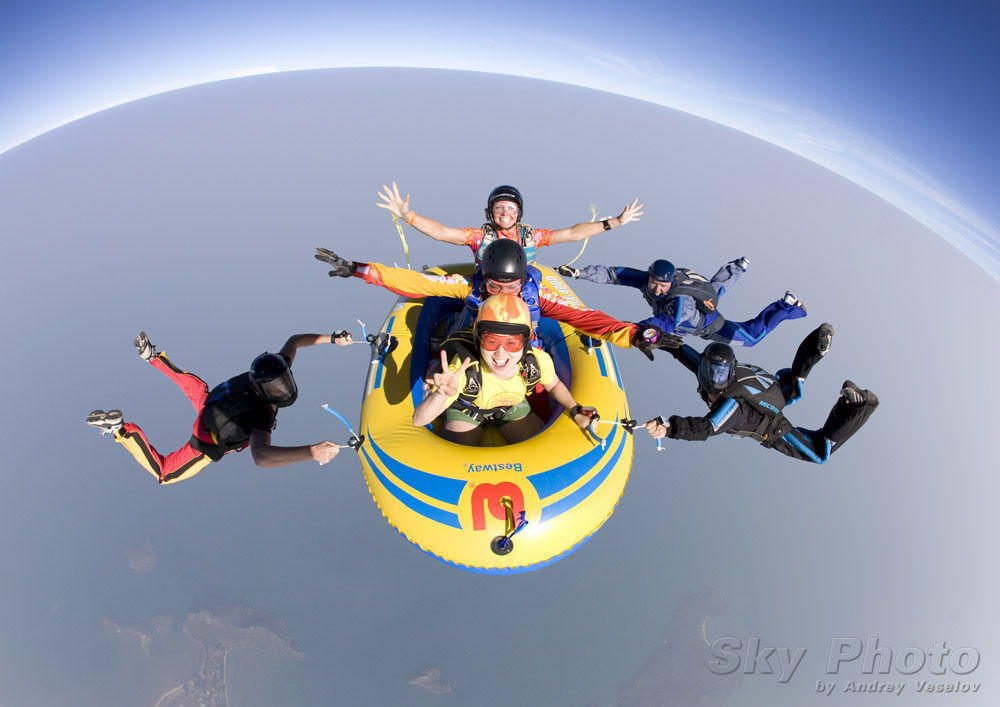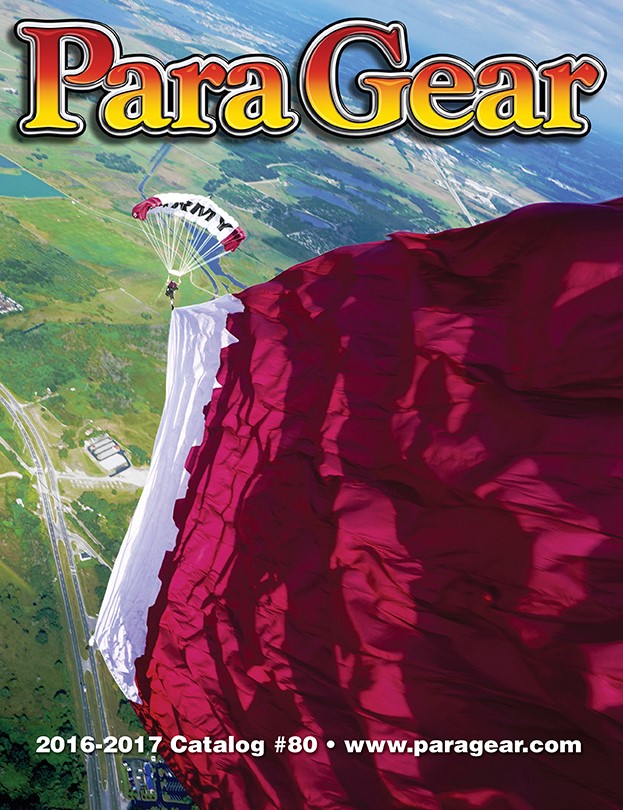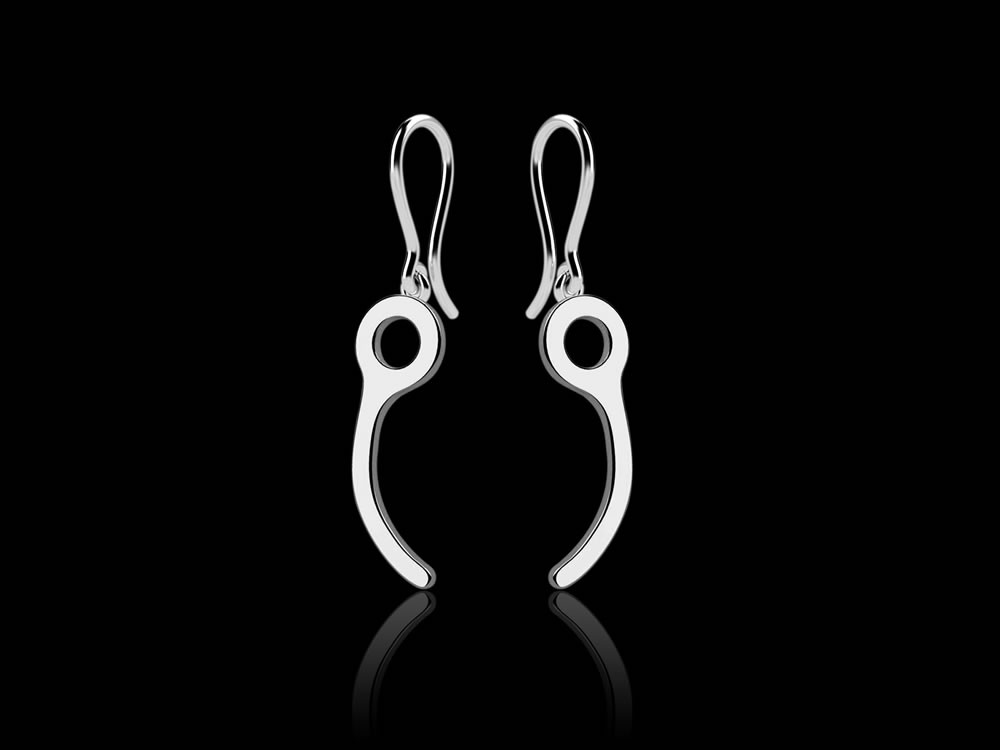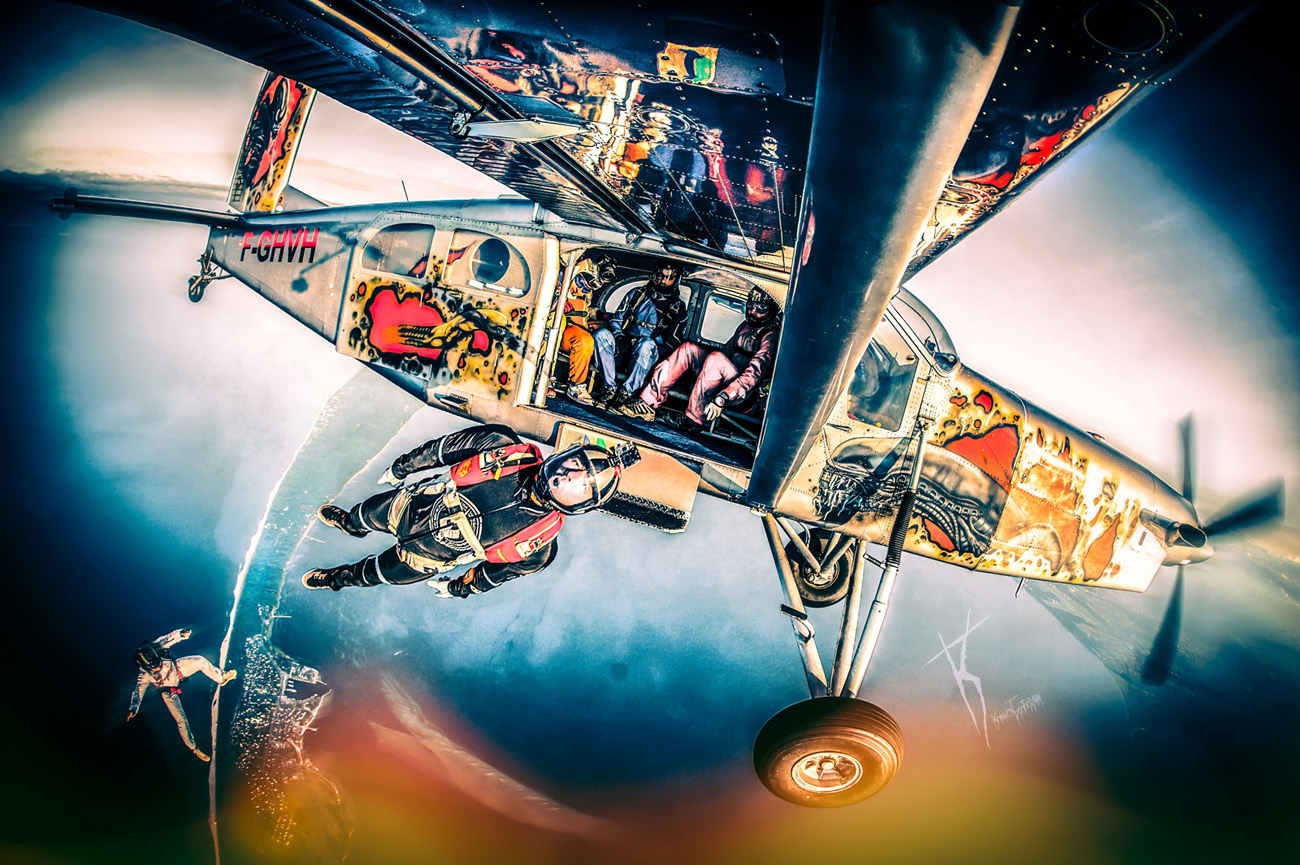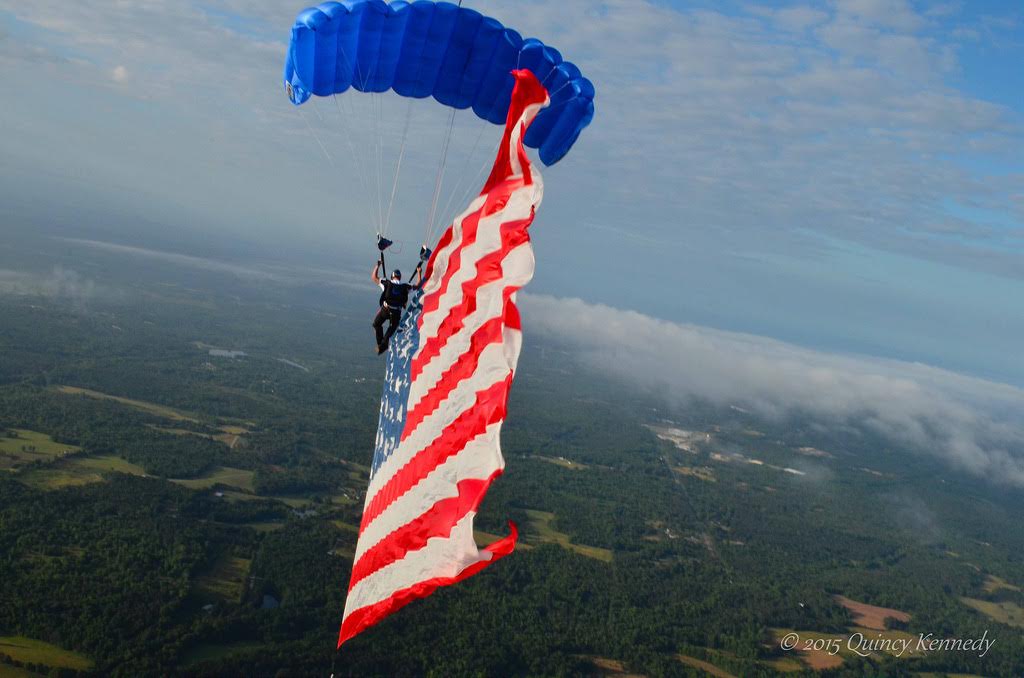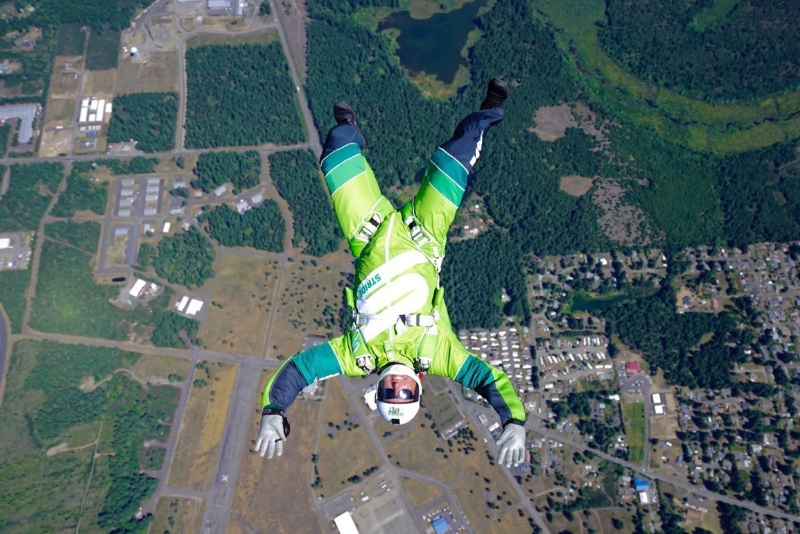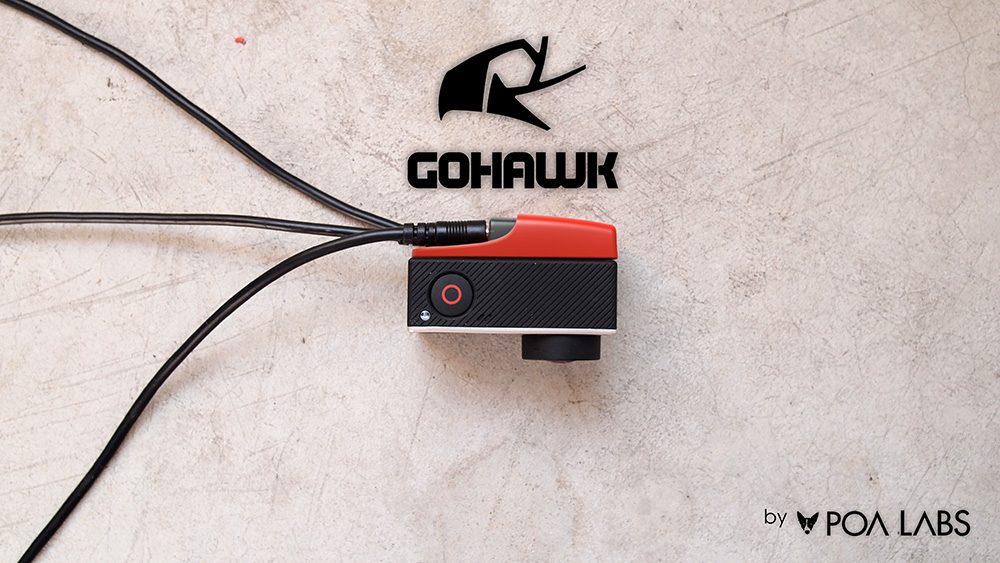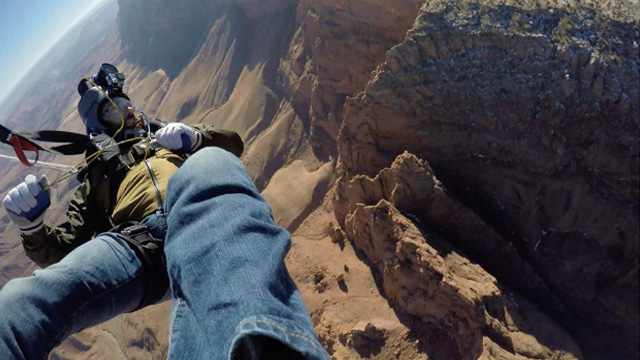Search the Community
Showing results for tags 'news'.
Found 523 results
-
A jump ship at Perris airport was involved in a collision with a fuel truck on Wednesday 24 May 2017. According to official reports, the plane was in the process of landing when it hit the fuel truck, causing damage to the front and the wing of the plane. The aircraft then spun out of control, stopping just short of one of the building structures. Despite a hard collision with the truck, and extensive damage to the plane, there was no fuel leakage from the truck after the incident. Only minor injuries were reported by one of the two individuals on board, both of whom declined any medical treatment at the scene. The situation could have been different had the fuel tanker leaked, or had the plane been going any faster. The 1976 de Havilland “Twin Otter” DHC-6 suffered severe damage to both the right wing and the nose of the aircraft. It wasn't immediately clear whether the aircraft was being rented by the dropzone or whether it is owned by Perris. After the series of plane crashes in the past 2 years, this incident will go down as a best case scenario, with no fatalities or severe injuries. The information as to exactly what happened to cause the plane to collide with the tanker wasn't immediately published, and would likely warrant an investigation prior to any public information being released.
-
Emma Tranter has helped airsports athletes get on--and stay on--the mat for 16 years. You’re next. So, full disclosure: This author has been practicing yoga for many years. I deeply believe that I couldn’t jump or fly without using yoga as a tool to undergird those activities, but it was so difficult to explain why that I generally deflected the conversation. After all, it used to be that chats involving yoga on the dropzone would end awkwardly (usually, with someone trying to fold themselves into lotus pose and falling off a barstool). These days, other airsports athletes tend to be much more receptive--but they often insist they simply can’t do yoga themselves, always calling in one (or more) of these three reasons: I don’t have time. I’m not flexible. I already work out enough. But what if I told you that these are all dismantlable barriers? That you can--and very much should--knock them down? And that it’ll measurably increase your sports performance? You certainly don’t have to take my word for it. Take Emma Tranter’s. Emma is a force of nature in our sport. A longtime-professional-skydiver-and-traveller-turned-extensively-educated-yoga-teacher, Emma has over 16 years of experience melding these two seemly opposing practices (and understands firsthand, the desires, aversions and excuses of the adventure-seeker. If you’ve spent time at Skydive DeLand, you know Emma for her yoga studio: The Yoga Shed, so close to Skydive DeLand that a well-thrown baseball will easily make the journey from the dropzone parking lot to the studio’s front door. Along with running her yoga studio, Emma currently travels the globe from her home base to facilitate Fusion Flow wellness retreats at various wind tunnels around the world, She does this with her twin sister, peak performance health coach, Lucie Charping. Arguably, Emma has the world’s most substantial experience in working with airsports athletes as they develop and advance a yoga practice. If anyone can break down the barriers between you and a yoga mat, it’s gonna be her. So let’s get started, shall we? ALO: Emma, tell us your abridged life story in the sky and on the mat. Emma: I made my first jump at home in New Zealand in 1994. I was professionally skydiving for many years--traveling all over the world for the sport. I eventually came to DeLand and stayed. I started teaching yoga in 2000, but I was still primarily a skydiver--packing parachutes and coaching at Skydive University and all of that kinda stuff. The balance shifted around 2003, when I completed a thousand-hour course in Precision Alignment Yoga. It was a two year training. It was awesome; I am still with those teachers. As the early 2000s went by, I started to get more more dedicated and committed to yoga. I transitioned out of professional skydiving but I stayed very active in the community, and I still fly regularly in the tunnel. The tunnel gives me more space in my life to dedicate to yoga, and teaching yoga is undoubtedly what I am supposed to be doing with my life. This is the sixth year of the Yoga Shed. Opening it in 2011 right next to the dropzone just seemed like the most natural choice in the world. I love to teach skydivers; they’re my people. And what skydivers find in a yoga practice is uniquely helpful to them. ALO: Does it still feel to you like people in these sports have the wrong idea about yoga? Emma: Oh yeah. A lot of airsports people--like the general public, I guess--still have the conception that yoga is about bending yourself into a pretzel or sitting on a cushion and omming. I mean, it is in some practices, but this is a very limited view. Airsports people tirelessly seek a state of flow. When you jump out of a plane or off a cliff and you’re not in that flow state, then that’s usually when things go wrong. When things go really right, it’s when your consciousness is in alignment; when you are fully present and not affected by your ego, when you aren’t thinking about what happened before or what’s coming in the future. You are just in that moment. Yoga gets you there. Airsports athletes make really good yogis because, once they actually establish the habit, they see the immediate, enormous benefits of the practice. They know what that particular flow feeling is when they meet it on the mat because it’s one of the central reasons they jump. The great news is that--once you’ve got the concentration required, when you can align the body and align the mind--then you start to experience that nowness that we all love in airsports whenever you want to. The trick is just to start doing it. ALO: Okay, Emma: I don’t have enough time. Emma: The first thing you have to do is be realistic as far as time goes. I always suggest the same question: How much time is realistic for you to dedicate to your health and wellness practices in order to support your flying, your skydiving, your BASE jumping...whatever it is that you love to do? Is it 10 minutes? 15 minutes? Half an hour? Most people will be, like, okay, I could definitely do 15 minutes. I take longer than that in the shower. Then I’ll say, “Okay. Let’s make this a 15-minute practice. How many days a week do you realistically think you will dedicate 15 minutes to do this practice? Twice a week? Three times a week? Fifteen minutes, three times a week, is very doable. I usually encourage my students to do their practice in the morning, before the day gets going and distractions come along. Can you get up 15 minutes earlier and fit it in before your shower? Do you see that as something that’s realistically possible? The majority of people discover that it’s quite easy to do. It’s more beneficial for people to do a 10- or 15-minute home practice every day than go take a class once a week for an hour and a half. When people start with a 10-minute or 15-minute practice and dedicate to it, that practice gradually lengthens in time. Suddenly that 10-minute practice that they were just going to get out of the way is 15 minutes long. And then, a month later, it is 20 minutes long, because they just felt like staying in it a little bit longer. In time, it grows and grows from within. But If you expect yourself to do a one-and-a-half hour practice, three times a week, right off the bat--if that’s unrealistic, then you’re setting yourself up for failure. If it’s that easy, why isn’t everybody doing it already? Find out in the next installment--as well as the reason “I’m not flexible” is the worst-ever reason not to take up yoga.
-
The wait is over! No one is more excited than we are here at Performance Designs. After years of development, hard work, and dedication we are delighted to announce our first wingsuit specific canopy, Horizon, is ready to order. In 2013 Performance Designs began development on a wing with emphasis on eliminating deployment problems caused by the large burble of wingsuits without sacrificing a great flare or responsive handling. When you have been making canopies as long as we have here at Performance Designs, this process is always evolving. The one thing that never changes is our high standard for quality, performance, and our focus on providing excellent products to everyone in our skydiving community. The result, we think the Horizon has the best openings and the best landing power of any canopy in its class! Best of all the Horizon gives you the ability to upsize as many as two full sizes compared to a non-crossbraced ZP main. This means you can fit a larger canopy in your existing rig for wingsuit jumps. No need for a new container! The Horizon features 7 cell construction Hybrid ZP and low-bulk 30 denier fabric consistent and reliable openings efficient glide when it counts responsive handling and a powerful flare slider presentation snaps HMA or Vectran Lines packs 1-2 sizes smaller than a similar ZP main Introductory Retail Price- $2100 Available in sizes 120-135-150-170-190 Horizon’s openings are stress free and comfortable, but they don't eat up a lot of altitude. Although this canopy was not designed to win any swoop meets, the response in flight is quite a pleasant surprise. With its agile response to control inputs, the Horizon is a joy to fly. It has a fairly long control range with excellent slow flight characteristics. Its dynamic response to braked flight turning inputs makes it an excellent canopy to conserve altitude as you fly back home from a long spot. The Horizon continues to uphold the landing performance that Performance Designs customers have come to expect. With a quick response to proper flare input it is easy to predict the “sweet spot” for a nice easy shutdown no matter what the wind is doing. Pack volume has been reduced significantly by combining our proprietary low-bulk fabric technology with our well known Zero-P fabric. In fact, the Horizon typically packs two(2) sizes smaller than a similar non-cross braced ZP main. The incredibly small pack volume easily facilitates easy upsizing for safety. In short, the Horizon is an easy off button to transition from wingsuit flight to canopy flight stress free. Pablo Hernandez landing at Skydive Dubai. Photo by: Ivan Semenyaka Do you have any questions? We might have some answers below! When can I get one? A: We will be accepting orders from PD’s Authorized Dealers as of today! (May 10th 2017). Standard production time will apply to the Horizon. These lead times are posted on the PD website at www.performancedesigns.com How do I buy one? The Horizon will be sold through PD’s Authorized dealer network. Interested customers should contact their local dealer to discuss if this canopy is right for them. Can I jump this without my wingsuit? We can’t tell you what to do with your canopy. Most people like the way the Horizon opens in freefall at terminal speeds when properly configured and packed. However, in order to get the most bang from your buck we recommend saving the Horizon for its intended wingsuiting purpose. How long will this canopy last? Putting a specific number on the lifespan of any canopy is quite difficult as it is impossible to consider all of the ever-changing variables that affect that canopy. A person who does 1000 jumps a year will go through equipment a lot faster than a person who does 100 jumps a year…and that is just one small piece of the puzzle. Our proprietary low-permeability, low-bulk fabric has proven to be more forgiving when subjected to the wake turbulence of a wingsuit deployment. We have added ZP to the center top skin and across the leading edge to enhance the performance and longevity of the Horizon. However, it does not possess the same durability that a canopy constructed of all ZP material would have. Following our recommendations for wing loading and taking the proper care of your equipment will go a long way toward getting the most out of your wing. With proper care the Horizon should bring you joy and happiness for several hundred jumps. What size should I buy? The fabrics utilized in the Horizon’s construction are part of what make this canopy so well suited for wingsuit skydiving. Because the characteristics of this fabric combination are different from traditional ZP, jumping a Horizon that is too small or loaded too high could demand a little more from the canopy pilot to ensure comfortable landings (when compared to an all ZP canopy in a similar size and design). Size your Horizon one (1) or 2 (two) sizes BIGGER than the smallest ZP canopy you are comfortable with. Roberta Mancino flying over Perris Valley Skydiving. Photo by: Sebastian Alvarez Your Wing Loading is also a critical factor in the performance of your Horizon canopy. Check out our Wing Loading chart on the Horizon page of our website. When considering what size wing is best for you, the size of the reserve in the container that you intend to use should also be strongly considered. It is always advisable to consult a certified wingsuit coach/ instructor when selecting a canopy to optimize your wingsuiting experience. For more information visit the Horizon page on our website www.performancedesigns.com Additional Information: Horizon Packing Manual Horizon Flight Characteristics Horizon FAQs
-
Squirrel wingsuits just released this amazing video, aimed at illustrating how wingsuits are able to climb in altitude. The concept of wingsuits being able to ascend was disputed by quite a number of skeptics over the past decade, but over the past few years we've seen evidence that not only can a wingsuit flyer gain altitude, but that they can ascend by a few hundred feet. At the time the claims were made, it was probably correct to assume that the wingsuits weren't gaining altitude, but that's only because the performance wasn't there yet. Wingsuit performance has seen a massive gain over the last decade with new companies like Squirrel getting involved in the market, and for the most part, dominating it. The increase in competitive wingsuit flying has also meant there is a larger drive for performance increases from manufacturers. Despite being one of the newest comers to the wingsuit market, Squirrel have already asserted themselves as one of the leading manufacturers in the industry and whose wingsuits have seen a number world cup wins over the past few years. In the video, a group of wingsuit flyers and organizers are seen plotting their flights and discussing what the risks involved with the jumps. The idea behind the video is that they would be using a large canyon in Moab, Utah as a point of scale for their wingsuit ascent attempts. In skydiving, it's generally quite difficult to judge the ascent, if any of a wingsuit flight -- not only because the increase in ascent isn't generally aggressively targeted as a goal, but because there is no static reference to give an indication on the altitude gained. The video, which provides some seriously awesome cinematography -- also shows us, for the first time, just how much altitude can be gained by these modern wingsuits. In some cases more than 250 feet were gained. The measurements were estimates based off both camera angle and in some cases GPS logs.
-
The world’s first human jump from the drone is accomplished Latvians have accomplished the world’s first human flight with the drone and jump at high altitude. On May 12, a 28-propeller drone built by Aerones has lifted a skydiver Ingus Augstkalns at a height of 330 metres, from where he accomplished the planned jump and landing with the parachute. Successful achievement shows the reliability and lifting-ability of the drone technology that approves unlimited possibilities for its use in saving people, fire-fighting, sports and entertainment. Ingus Augstkalns, an author of the idea and skydiver: “Emotions are fantastic. Both feeling how easily and quickly the drone lifted me, and because Latvia proves itself in innovations of technology. It is obvious that we will experience an increasingly important use of drone in our everyday life. Definitely also my friends skydivers all over the world will be excited about these new opportunities. We live in an exciting time.” Jānis Putrāms, a chief engineer of Aerones and a pilot of the drone: “Already in the near future, our technology will save human lives, will help to fight fires and carry out other challenging and significant work. With this project, we show that we are ready for serious tasks in the field of civil defence and sports.” The jump was accomplished in Māļi, rural area of Amata, Latvia, in cooperation with the State JSC Latvian State Radio and Television Centre (hereinafter -– LVRTC), whose communications tower of 120m was used as a platform for the jumper. In order to reduce potential risks, the drone took the jumper from the tower of 120m and then lifted up in the height intended for the jump. Preparations lasted six months, at which time the payload of the drone increased up to 200 kg and a number of tests were carried out, including the flights with the jumper over the river Daugava. Aerones is the Latvian drone manufacturer that is focused on the development of drones with high lifting power. Ingus Augstkalns is an experienced skydiver and a wind tunnel flyer. He also is a co-founder of innovative technologies companies AERODIUM Technologies, Cube and Captomatic. We thank our partners Latvian State Radio and Television Centre, FILMORY, FlyVision, SABI, f64, AERODIUM, Civil Aviation Agency and Skydive Latvia for cooperation and support for project implementation. Editor's Note: With the exit altitude being just 330 meters, some may consider this more of a BASE jump than a skydive. Whatever you classify it as, we classify it as awesome. www.aerones.com www.facebook.com/aeronescom www.twitter.com/aerones_com
-
The Mutant is a purpose-built swoop harness and container system that is a swooping game changer! Designed by Vince Reffet and Blikkies Blignaut, the Mutant is significantly different than a standard sport rig. The risers connect at the hips, similar to that of a speed flying harness, and control is initiated more by weight input than toggle pressure. The laid back, supine position of the pilot reduces drag which ensures a super long and fast swoop. This innovation significantly changes the flying dynamics of the canopy which means the Mutant is not suitable for all flyers. Jumping the Mutant requires training and a high level of experience; those with speed flying harness experience will realize an easier transition than those with no supine harness experience. Here's what some of the early testers have to say about the Mutant: It only took me a few seconds under canopy to realize that the increase in performance with the Mutant was phenomenal. The performance envelope is increased and the sensitivity through the harness is shocking. After a couple of jumps I up-sized to give me time to get used to the increased in control. I feel like the harness adds another dimension to the canopy, like it's on steroids! -Pete Allum The biggest benefit from flying a MUTANT harness is that you can control your pitch angle just by using weight shift , there is no need to pull the front risers to dive neither to use the rear risers to recover if done right, just leaning forward makes you dive and leaning backwards helps you to recover with less wing distortion as you barely apply any input on the rears. -Pablo Hernandez This harness is so awesome! It is the most comfortable harness period. It's the next step up in high performance parachute flying. Relearning to fly using the hip attachments is fun and challenging. The mutant harness automatically makes you feel like you just down-sized. It turns your katana into a velocity and velo into a peregrine. -Jarrett Martin "I think the name says it all :D Mutant. A hybrid between a paragliding harness and a skydiving one. I have been intrigued by it since the first time I heard about it and when I saw it I realized it is the obvious step ahead. It is very fun to fly but because it is so different, we will have to relearn and redefine a lot of what we know about swooping. The skydivers with a paragliding/speedflying background will have an easier transition to it. I am excited to figure it out even though I know it might take me some time. It is definitely worth the effort. The next generation of skydiving harnesses is finally here!" -Cornelia Mihai My bro and teammate Vince Reffet has been working on it for a long time and I can only thank him for putting all these efforts into it!! This harness is a door open to a new era of skydiving, it's been a long time that I didn't have that much fun under canopy!!! I did a lot of speed riding and paragliding and the mutant is a way to get the power of the canopy control that you can have under a paragliding wing but in skydiving! such a blast to go from a position that is standing up to seating and then be able to use the weight to move so fast and so powerful!! it is really a new world. thank you vine and thank you UPT!!! -Fred Fugen Stay tuned for updates about the Mutant release.
-
Holistic Performance Specialist Lucie Charping Talks You In Image by Juan MayerIn our last article, we met holistic nutrition coach Lucie Charping, who works with elite athletes to get them--and keep them--at the top of their game. Often, that game is an airsport. Here’s the continuation of our conversation regarding peak performance strategies for more “normal” airsports athletes, like you and me. (Spoiler: These strategies work just as well if there isn’t a charging bull on your helmet.) ALO: If going cold-turkey on every naughty item in your diet isn’t the way to peak performance, then what is? Lucie: Changes made little-by-little help an athlete increase awareness and get in touch with their body’s natural intelligence by balancing the systems that run us. In actual fact, we're healed by those same systems that keep us going, so--if you balance those systems, such as blood sugar and pH--you'll be setting yourself up for a broad spectrum of positive effects, healing from stress and sports injuries among them. Make better choices until you build the momentum that gets the pathways programmed. ALO: It sounds just like establishing a yoga practice. Right? As soon as you keep the promise that you're going to do it for five minutes, before you know it, it’s 10; 20; 40; 60... Lucie: Absolutely. People think it's matter of willpower. It’s not. It's really a matter of neurobiology--what's happening in your brain, what's happening with your biochemistry, your neurotransmitters, what's happening in your gut--that’s making the decision about what you're going to eat. You can’t fight your hormones. No matter how strong of mind you think you are, you're ruled by your chemistry. You are strong of mind because of your chemistry. So: If you get your chemistry in alignment, you’ve essentially learned to hack yourself. You can not only be happier, more effective, more creative and more motivated in your daily life--but if you’re the kind of person who relishes a heightened-stress, high-consequence situation like skydiving, tunnel flying, BASE jumping, etcetera, then you’ll get even more benefit from this kind of management. You’ll learn faster, you’ll have faster decision-making and you'll have more focus to excel in these unique sports with their unique pressures. Of course, I could say to you, “Here; go to the dropzone with this power-packed superfoods smoothie of maca and cacao with all these berries in it.” And it would be super awesome, of course; it’d give you a short burst of energy for a short amount of time. But it’s not sustainable to do that every time you go to the dropzone; every time you go to the tunnel. If you learn how to balance your blood sugar, you're going to have an abundance of energy for an extended amount of time, and you don’t have to plug a blender in next to the packing mat. ALO: Let’s talk a little more about energy. It’s a big part of airsports to manage your energy when you’re waiting on loads or tunnel rotations or weather, and a lot of airsports athletes struggle with it. How can this stuff help with that? Lucie: The peaks and valleys in these sports are quite steep. I see a lot of adrenal fatigue and overactive minds in the group of people that I work with. For this, I’ll use the term “extreme sports,” because these athletes like to push their minds and physiologies to the extreme. When you put yourself in a high-consequence or high-risk situation constantly, the chemistry that is firing in your brain is full of reward chemicals. It’s highly addicting. Over time, you reset your brain’s baseline for what it means to feel good. When you're on the ground or on the bench, those reward chemicals are not firing. So, what happens is--more often than not, and you can correct me if I'm wrong--we have major addictions in these sports. Not just to drugs, though that is certainly within the landscape. We have addictions to sugar; caffeine; tobacco; all kinds of stimulants, and you can see for yourself how people are having to use those things constantly between jumps and flights. It's not because the individual a yahoo; it’s because their baseline chemistry is telling them this is what is required for you to feel happy now. So, on the ground as an action sport or, say, “extreme sport” athlete--for peak performance, you must learn to cultivate that chemistry whilst not risking your life. And you do that with the food that you eat and with relaxation practices. You can keep your blood sugar level, which keeps your mind and body in a receptive state, then cultivate that satisfying chemical response through breathing. Then you won't have to reach for an energy drink every time you pack, bouncing from one coffee to the next, not eating all day at the dropzone and then binging whenever you manage to get home. Peak performance comes with time. And so, it’s interesting to note, does optimal health and weight, without calorie counting, or deprivation, or guilt. ALO: It sounds way simpler than I thought. Lucie: It’s not really simple, it’s elegant. To me, that's where the power is. If you want to talk about what is both the barrier and the bridge between business as usual and peak performance for airsports athletes, it’s a single path, and it’s not complicated: cultivating these practices of prioritizing your food so you balance your body's chemistry and practicing mindfulness techniques in order to bring a single point of focus to your mind. Not only do you get better at jumping and flying; you become happier as overall person. Your body is magic; it's magnificent, actually We often forget about that. But we never, ever should. ------ Lucie is based in San Diego, but travels to wind tunnels worldwide as the nutritional arm of Fusion Flow Retreats. To reach out to Lucie for a personal consult, pop over to her Facebook page.
-
Holistic Performance Specialist Lucie Charping Talks You In Image by Serge ShakutoLucie Charping grew up in the world of food and hospitality--but quite a bit more actively than you might imagine. She founded her first restaurant, in fact, at age 16. Lucie made the food-to-medicine connection early, too. Plagued by a variety of ailments throughout her childhood (as well as adrenal fatigue and a battle with anorexia, which almost killed her), Lucie healed herself through holistic nutrition. Eighteen years later, Lucie’s expertise centers on peak performance, sports injury management and plant-based nutrition--with a particular focus on lifestyle strategies for adventure sports practitioners, elite and Olympic athletes. I had the opportunity to pick Lucie’s brain about peak performance strategies for skydiving (and the shredding of tunnel gnar, to boot). Here’s what she had to say. ALO: So: tell us what you do! Lucie: I'm a peak-performance health coach. I’ve been a holistic nutrition coach for about 18 years. Originally, I worked exclusively within the Ayurvedic model--Indian medicine. These days, there is so much more western science and up-to-date nutritional information available, so I extended my practice to encompass it. The focus is two-pronged: first alignment, then optimization. Once you align your systems, the body can optimize. Most of my clients are adventure athletes of some kind who want to heal from their minor injuries faster; who want to be faster; who want to be clearer in their path towards performance in air sports and who want to have the mental energy that is takes to do these sports well. ALO: At what stage along this path do you usually meet a new client? Lucie: Usually, they come to me already having had an inkling of what needs to be adjusted. With a little bit of age and experience, top-level athletes--and people who want to become top-level athletes--discover for themselves the power of food-as-medicine to improve recovery rates, reduce inflammation, oxygenate more efficiently and focus better. Soon after that, if they’re paying attention--which they are, at that level--they realize that without using nutrition as a tool, they’re effectively shooting themselves in the foot. People come to me because they’re starting to realize how important it is and they want a customized, individualized plan of action--but you can do it for yourself, of course, if you’re willing to put in the research. You’d think that in top-level sports--airsports included--people would know what they need to know about nutrition. Unfortunately, they don’t. In order to be light and strong and focused, you need to eat and balance your body systems. ALO: Most folks that I know who do anything in the human-flight realm are under the impression that they’re doing pretty well, nutritionally. What’s the biggest problem you see with nutrition in airsports specifically? Lucie: In airsports, I come up again and again against the fact that people live predominantly on sugar. Soft drinks and lab-created bars are the major culprits behind the energy rollercoaster. Protein powders and bars replacing real food is a close second. There’s a perception that crap food is par for the course when you’re in the tunnel at 2 o'clock in the morning or out on a dropzone for the weekend--and then you don't know why you can't focus anymore, you don't know why you keep injuring yourself, why you're so frustrated all the time. It’s a matter of blood sugar and stress responses. Once you get your blood sugar and your stress responses under control, the training can rapidly come together. If you manage your body chemistry and your neurochemistry, you can absolutely catapult yourself. You can actually create an environment that sets you up for a state of peak performance--for a flow state. You can cultivate those states within your body, and how you do that is through your food choices and your relaxation practices. We all have these systems built into our bodies; we just need to learn to use them properly. There is a lot of science on this now--about how food choices and relaxation practices can optimize your learning rate; your motivation; your creativity; your focus. You can halve your learning time, for instance. The benefits are across-the-board. ALO: Let’s take a look at your typical skydiver. By that, I mean somebody in their late 20s to mid-30s who thinks that they eat pretty well, but definitely drinks socially--and probably has more quote-unquote “cheat days” than they would care to admit. This hypothetical jumper is starting to feel their age kicking in; starting to feel a little bit less, shall we say, unstoppable; starting to get the little nudges from their body that say something needs to be changed. What are the steps that you first recommend to that person? Lucie: The first thing I ask is simple: Are you eating enough food? Because in airsports--as in most sports--athletes don't eat regularly enough to balance blood sugar. Hangriness is hypoglycemia, which is crippling to an athlete. You can easily manage your blood sugar with plant protein and fiber (for example: hummus and carrots), even while you’re moving quickly at the dropzone. No matter how transient you are, you must think am I eating regularly enough and is my blood sugar stable. That’s step one. ALO: So you’re not telling people to drop everything and go raw vegan. Lucie: Absolutely not. I don't actually agree with that, anyway. I think that a whole-food, plant-based diet is the way forward for health and performance--but, as a coach, you have to meet a person exactly where they’re at. I can prescribe my perfect formula, but it will be a set-up for failure if the athlete can’t or won’t adhere. ----- Next week, Lucie talks about her favorite strategies to make that plan and stick to it.
-
Jill Grantham is a travelling gypsy from Australia with 1900 jumps and 12 years in the sport. She has hair like Rapunzel, a penchant for lords and ladies and is as sweet as her favorite candy. What is your canopy flying experience? I have historically been a consistently terrible canopy pilot due to low confidence (slid in on my butt for 11years). Before I got Lady Safina (my new Safire 3 129 from NZ Aerosports) I was flying a Safire2 139, for 800 jumps. I have now done about 150 jumps on Lady Safina at a bunch of different dz’s with weather etc. But I am loving flying this canopy. Lady Safina, how I love thee, let me count the ways: Amazing flare! No matter what sort of things I do with regards to my landings (I’m currently learning to do a front riser approach) there is always a good enough flare to stand me up. This is giving me the confidence to try and progress to higher speed landings rather than straight ins and not worry about getting dumped if I come out too high. Slightly easier to get on the front risers Slightly faster opening than the Safire 2, which is not too fast and helpful to not be hanging up a slow opening canopy in amongst traffic. More responsive to harness turns. Feels more solid in bumpy wind conditions Heaps and heaps of range to get back with the rears from a long spot. Plus she is really pretty.Is there anything you don’t like about the Safire 3, sorry, Lady Safina? She is a Beta test canopy that was built for me before the Safire 3 was released to the public. I was having inconsistent openings to begin with. After filming some openings and sending some feedback a mod was made to mine and all subsequent Safire 3 models - and now she opens great! What do you notice different in the Safire 3 to your previous Safire 2? I feel like the Safire 3 is just overall more responsive. I definitely feel like I am more in control and can actively fly her. We work together a bit more. With the Safire 2 I felt more like a passenger. Could have been the difference in size a little too of course! The rears are better for getting back from a long spot and the fronts are a bit easier to get on than the Safire 2. She still pulls out of a dive pretty quickly - you can’t hold the fronts down too long before they’re pulled out of your hands. Who is the Safire 3 suitable for in your opinion? I think she is suitable for beginner and intermediate canopy pilots. Especially good if you are a bit nervous or don’t want to push it, you can have a lovely safe easy flight to the ground. You have heaps of range to set yourself up in the pattern, which helps you not become cornered by having too small or too big a canopy...and if you don’t want to do much other than float down softly it will allow you to do that. If you do want to start flying it more, and seeing what you can do with it, then it is a really responsive wing and awesome to try out some new things on. But because the flare is so good it doesn't matter soooo much if you don’t nail the landings while you’re learning, because the canopy sort of fixes your little mistakes up :) What's the main benefit or advantage to you personally of having a Safire 3 rather than another canopy? Aside from her being the prettiest Lady I have seen? When I’m flying her I feel comfortable enough that I can choose what is appropriate for the situation and group and fly her how I need to to be safe and keep everyone else safe too. The increased responsiveness and flare have made me confident to try more when flying her. She has really changed my attitude towards skydiving. I feel more in control of how I am flying her rather than feeling a little bit exposed to the elements. She is basically all those empowering girl songs in canopy form!. ** Jill Grantham received early access to the pre-released version of the Safire 3 gratis from New Zealand Aerosports. The article above was Jill's unpaid opinion on her experience with the canopy.
-
As one of the most experienced pilots in the world, Jarno McCordia is continually involved with things at the pointy end of wingsuit flight. Following on from providing details about the new wingsuit tunnel in Stockholm, he shares some information about a more personal project that aims to answer a question that continually bothers us as humans: “What happens if we strap rockets to it?” “In a way this project started back in 2005 when I first saw Finnish wingsuit pilot Visa Parviainen experimenting with the first set of small jet engines. I had been involved in helping him with some media stuff around 2010, and at that point it really sparked my interest. It had always been a secret longing, but at that point I really got inspired to try and turn it into a reality.” “Every wingsuit pilot dreams of flying with unlimited range and power - to turn yourself into a true flying machine. Visa took that and turned it into a reality. He worked for years to develop the idea, logging longer and longer flights, aiming for level flight and then the ability to gain altitude.” While Jarno concedes that other high-profile projects that utilise similar technology have helped to draw attention to his plans, it has taken a lot of work to get it up and running. ‘It took quite a few years, and many dozens of sponsor proposals to finally get the project of the ground. At the moment we are midway into construction on the fuel setup and engine mounts, our software engineer is almost done programming the custom onboard computer that will control and monitor the engines, and provide various safety features related to matching thrust and (automated) startup and shut down sequences.” “Engine technology and wingsuit design have both come a long way since Visa's first flights over a decade ago, and it is going to be exciting to see how far we can take it. We have a team of aeronautics designers helping with the engine mounting and fuel setup, and experts in construction making the gear. Visa himself has been involved from the start, providing us with a great deal of knowhow and practical information - as well as showing us his setup and design ideas.” Unlike the various rigid wing systems we have seen over the years, your plans appear to utilise fairly standard wingsuiting gear. What have you had to adapt? This is one of the main goals for the project. I’ve surrounded myself with a lot of experts in various fields and we are trying to design a set of gear that can be added to any normal wingsuit/parachute system. I will be using a bigger canopy due to around ten kilos of added weight I will have on landing, but thanks to recent advancements in ultralight fabrics and canopy design it will fit into my normal rig. So when can we all have one? I am not sure that buying a jump ticket and getting on a plane with a tank of Jet A1 strapped to your back and engines blasting super heated exhaust at 600 mph will ever become standard, but for me this is a dream project and I'm trying to get as many knowledgeable and skilled people as possible involved to help it become reality. An important personal goal is to develop a system that is as safe and easy to use as possible, and I think approaching the design process from the point of view of that anyone should be able to use it is a good place to start from.” How long until we can expect to see you in the sky? “We do have a date we're aiming for in terms of the first flights, but we are keeping that off the record for now. It is crucial to let safety, finalised designs and a thorough testing process dictate when we a ready to go. My biggest wish for the whole project was to make it safe, accessible and of course as awesome as can be.” Project manager & Pilot: Jarno Cordia Made possible by: IGOFX, AMT Jets, Phoenix-Fly Programming & Technical Setup: Martijn Decauter Technical Realisation & Construction management: Jean-Louis Becker / NL Ballon Aerodynamics Design, Tunnel Testing & Support: DNW Aero
- 5 comments
- 1
-
- interviews
- interviews
-
See more
Tagged with:
-
With more than four thousand jumps over the last fourteen years, Jarno McCordia is one of the most experienced and highly respected wingsuit pilots in the world. Here he joins us to discuss a couple of upcoming projects from the pointy end of wingsuit flying. First up is a look at the soon-to-open indoor wingsuit facility in Stockholm. Towards the end of 2016 footage began to emerge of an angled tunnel facility in Sweden where some ambitious aeronautical engineers have been conspiring to do for wingsuit flying what vertical wind tunnels have done for our skydiving skills - change everything. Brought quietly onto the project in early 2016 by the founder of Phoenix Fly and wingsuit development grand wizard Robert Pecnik, Jarno immediately saw the potential: “The whole thing was already underway a fair bit when I got involved in an active way. Secretly Robert had already been working for almost a year with the team behind the technology to realise the project. The first test flights had already been done when I was invited to come take a look at the flying and help assess things - mostly from an instructional point of view but also to see how far we could push the flying. Normally a lot of the development and testing we do together is open and shared process - so to have Robert tell me he had some news but couldn't show me anything until we met in person made me suspect it was something big.” “The flying I saw at that point was just steady cruising, but it immediately made me realise what I was seeing and the potential of how it could change the sport in a similar way that indoor skydiving transformed Freefly and FS in terms of skills and training.” Many disciplines within skydiving are evolving quickly and wingsuit flying is no exception. Suit designs are continually updated as our methods are refined and our abilities better understood. Steep and fast is the way to maximise the potential of a wingsuit - but getting it right takes time. How does the tunnel work and what have you learned about the instruction process so far? “The whole tunnel chamber is a moving structure of which the angle can be altered from pretty much flat to almost vertical. This ability to do this gives us a glide ratio varying from 1:1 all the way up to 3.65:1 (comfortably more than the sustained full glide on high range wingsuits) and the controllable speed of the tunnel is from 0 to almost 300km/h. Balancing these two factors means the tunnel is able to match the glide angle and for the suit one is flying and be appropriate for the skill level of the pilot. We have looked a lot at the teaching technique for beginners as we see that as being a significant percentage of customers. Experienced wingsuit pilots will also need to learn the basics first so that was an important area to focus on.” The indoor skydiving industry has a complex system of managing students abilities while they are training developed over many years . With good quality instruction accidents are few and far between but there is still some inherent risk. What have you learned so far about keeping people safe? “In terms of spotting and safety, procedures will vary a lot from what people are used to. I cannot go into to much detail yet due to a pending patent, but there is an assisted flight system that holds the student in a central position in the tunnel. There is free range of movement in all directions but only up a certain degree. In a similar way to how a seatbelt works, any rapid movement towards the ground or the walls is halted in a gentle way. Once pilots reach the stage where they can fly around free without any assistance it will be possible to get into close contact with the floor and walls, though experience has shown that the lower windspeed and design of the tunnel make those situations a lot less severe than one would expect. I’ve been practicing some quite aggressive acrobatics and of course it does not always go down without a hitch, though due to the padding and angle of the chamber you never really hit hard and you get gently rolled down to the floor - feet first.” “Initially there is something very intimidating about flying in a confined space but it pushes the accuracy and precision of your flying to a new level. It has definitely helped me realise how much further we can develop the precision of our flying. Even in the smaller test setup we have been flying 2-way and performing advanced acrobatics. Once the full-scale tunnel opens in September the possibilities are limitless - we are already going to host the first indoor acrobatics competition in December. LT1 is currently scheduled to open in September 2017. You can read more about the project and the history of the facility here: https://flywingsuit.se/
-
Each year some of the manufacturers show off some unique and exciting rig designs at PIA, sometimes these rigs are actually able to be put into use, while others are simply demo rigs to show off some really cool design concepts. This year saw a couple of really awesome looking rigs, with a transparent rig from Sun Path and an amazing "steam punk" rig from the guys at United Parachute Technologies. United Parachute Technologies Sun Path Which of these rigs would you most like to be flying?
-
With the release of the new ProTrack 2 we have a look at exactly how many more things it offers. ProTrack II DesignWhen falling through the sky it is not only a jolly good idea to have a little gizmo the beeps in your ear to remind you to do stuff - in many situations it is mandatory. For some people the simplest set of warnings are sufficient - one distinct electronic chirrup for each of break-off and deployment, then an angry screechy one for being lower than is safely acceptable/possibly getting told off about what you just did. However, even the most rudimentary electronic devices now come packaged with a tiny computers buried inside that have enough computational power to perform orbital mechanics and help serve the purpose of pacifying your life’s need to do anything much other than binge watch old episodes of Deep Space Nine on Netflix. Original ProTrack DesignI bought an original ProTrack as my first set of beeps back in 2007 as I am a big nerd and it was the most fanciest audible altimeter available. I remember being tremendously excited about how it allowed me to download the accumulated digital data from my skydives and then produce graphs from the correlated information to share on my MySpace page - thus proving beyond all doubt I was both cooler and smarter than the people who laughed at me in school for my ongoing interest in toy soldiers. Technology moves fast and our insatiable appetite for mobile phones that do more and more has led to some mind-boggling miniaturisation in our daily lives. We are now very used to tiny electronic doodads with little screens that do many things. So - we some beeps to remind us of a few important things in freefall, but how much more is it possible or necessary to do with an audible altimeter if we apply the technology we have available now? With this update of the ProTrack, what Larsen and Brusgaard have done is smoosh together the features of the original device with those of their flagship audible altimeter - the Quattro - then sprinkle it with some modern goodness that we recognise from things we see every day in phones and such. If we break it down the ProTrack 2 can be divided into categories as follows:Things ProTrack Did Already: Mass Storage: It records the details of your jumps. Including accumulated freefall time, which is nice - especially if you find adding up units of time a pain in the ass. Connectivity: There is much to be said for a digital record of you achievements. A meticulously crafted pen and ink logbook is beautiful artefact of your skydiving career (and still a requirement for advancement in many places), but equally splendid in a different way is a lovingly curated online adventure zone that enjoys all the fruits of modern computing. Exit/Deployment Altitude: With time one learns that the altitude advertised by a Dropzone is not always what you get. Many variables determine your precise altitude when you are when you are in the right place to get out of the plane and mostly it is not a big deal. It is nice to have proof if you find you are getting fleeced though. Things The Quattro Does That The ProTrack 2 Does Too:Low Speed Warnings: These are the swoop alarms we know and love. They are programmed to register low freefall speeds too, which can be right useful if you are into complex wingsuit flocking where they can be set to signal points along a flight path or breaking into groups or stuff like that. Beeps Going Up: Having settings to signal certain altitudes in the plane is a convenience that can be beneficial. Efficiency with your jump preparations leads to safer and better skydive and good awareness is crucial. Always On: You don’t have to remember to switch it on and off. Unless you want to. New Things The ProTrack 2 Does Now:Micro USB: Which seems so normal but is new and exciting as the old model came with a cradle thingy that had required you to have a serial port (a serial port?) or, for Mac users - some kind of laborious solution. The JumpTrack software offered by Larsen and Brusgaard has been around a good while and although due for an overhaul it is still used around the world. Live Jump Playback: With 2MB of internal flash memory the unit is able to replay the speed profile of your jump in real time. (Approximately 200 jumps with 2 minute profiles or 26 jumps with 15 minute profiles). If you are prepared to put in some effort (like watching side-by-side with video) there are things you can learn from this. Economy Mode: These devices don’t use very much energy and if you get the batteries from somewhere sensible instead of a dropzone shop then they don’t cost very much. However, If your jumping is random or infrequent then the ability to actually switch it off properly means your battery will last a while longer. A modest boon, but nice if you gain satisfaction from managing the small things. Useful but very 90s looking software. Note the attached videos and imagesWhile there are undoubtably people out there who just desire some beeps that beep at the right time and nothing much else, devices like the ProTrack 2 offer extra information that can be very valuable for those that are inclined to manage and study it. Skydiving represents a huge investment in your own skill and experience, and the ability to analyse accurate, reliable data relating to trends in your performance is another way of squeezing a little a little more from your jumps.
-
We're at the PIA symposium this year, scouting out what the manufacturers have lined up for release this year, and we've managed to grab some images to show you what has just arrived on the market and what is coming soon. Check out the following items and let us know in the comments section which ones you're most likely going to be picking up once they hit the shelves. Alti-2 - Chronos Cookie Composites - M3 Larsen & Brusgaard - Pro-Track II Sun Path - Aurora Airtec GmbH - Wingsuit Cypres
-
If you add a little pressure, simple things can quickly become not-simple things. For the amount that most of us understand about how they really work, the modern cameras we employ for skydiving are close enough as to be made of magic. Yet despite their tiny size, amazing quality and all-round wonderfulness - we still regularly miss out on capturing quality footage of a jump for the most arbitrary reasons. A little bit of forethought and the application of a simple routine can aid ones consistency when it comes to getting the shot. You may well snort derisively and roll your eyes at the thought of reading an article about how to switch a camera on - yet let you that has never missed a great bit of action for the sake of some small piece of angry-making bullshit stupidity cast the first stone. The best analogy I have to represent the advantages of a sensible and efficient method for a repeated process is think about packing and how much of a frustrating pain in the ass it was (be honest) at the start. Learning to pack and getting it right is not only about understanding the need to fold your parachute a certain way so it will go into your container (and come out again) - it is as much about the knowing right spot to put your knee so the fabric doesn’t escape and where to hold it down with your elbow so you can have both hands free for the next bit. How many things in your life are there to which you can draw parallels with this? There is much satisfaction to be found in developing your ability to get ready quickly and efficiently in the plane. Here are a few tips: The Plan:Adding things to your in-aircraft routine should not come at the expense of any of the stuff you have learned to do that makes you safe. If you are skipping over running through your drills because you are constantly fucking around with your camera you might forget them at the crucial moment - so don’t. Even in the speediest of flying machines you have time to do things both necessary and desirable, but always remember your priorities. Checking that your pilot chute is not hanging out is vastly more important than which recording mode you are in. Lenses:It is very easy to get some manner of obfuscating crap on your lens. Action cameras all have teensy little apertures onto which a single grubby fingerprint is enough to ruin your footage of the bestest jump ever and make you very sad. Condensation is very popular too - especially with big temperature changes from altitude to ground level. Moisture developing on (or even in) your camera during a jump is unavoidable but not cleaning it up before the next one definitely is. You should have a suitable cleaning cloth somewhere about your person - tucked away into the lining of your helmet is good as it makes it very difficult to bring one without the other. For extra points you can attach it to your helmet with some string, or you could even carry a spare one which you might magnanimously gift to some clothless boob and appear as a minor hero/enormous geek in front of like four people. Cutaway:More and more frequently dropzones are requiring that any helmet with a camera on is fitted with a cutaway system - which are available in many forms and levels of quality. The best idea is always invest in a good one that someone has made using science that will actually work rather than bodge something together yourself from that box of old skydiving bits you keep under your bed for no good reason. A worthy part of your pre-jump process is to give this a quick look and see if all is well, and that nothing has become worn or unseated that might result in no camera attached to your head and some cognitive dissonance about wether you can be bothered to scour the landscape looking for it. Using Time:For maximum sensible-ness you should perform your camera checks with enough time that you can fix potential problems without freaking either yourself or anyone else out if something is amiss. Realising on jump-run that your memory card is full or your lens is dirty is too late. If you had a spare thirty seconds you might be able to go into your settings and delete something to free up space, or give the front a quick clean - but not when everyone is already climbing out on the side of the plane and waiting for your ass. ConclusionBeing correctly prepared in a timely fashion is but one step in getting good footage, yet an important one. Felling relaxed and properly ready lends itself to nailing the jump, and the exact form of your personal routine will develop with time and practice. Stick to the plan, don’t bump your head on the way out and remember that you get what your head is pointing at, not just your eyes.
-
The History of a Silly Name Image by Andrey Veselov It’s hard to imagine that, not too long ago, a skydiving get-together was a rare thing indeed. Today, as you’ve no doubt noticed, there are hundreds of ‘em. In fact, almost every drop zone, no matter how small, has at least one official yearly boogie to celebrate its local jumpers. Namibia! Fiji! A tiny little beach town in Kenya*! A big field in Montana! Where two or three are gathered in its name, behold: you’ve got a boogie on your hands. Some of these events are immense, filling the skies with dozens of wildly various aircraft, hundreds of skydivers and a whirling (terrifying?) smorgasbord of disciplines. Others are comparably tiny. Despite their differences, most boogies are a reliably good time. It stands to reason that a group of skydivers would find any excuse to come together in a frenzied combination of daytime skydiving and nighttime frivolity–but when did the first one take place, and how did it come by such a goofy name? Read on. The Birth of a BoogieThe modern skydiving boogie may owe its existence to a film: specifically, the first major skydiving film released to the public, called Gypsy Moths. Shortly after the film’s much-lauded debut, one of the skydivers featured in the film – a prominent skydiving athlete named Garth “Tag” Taggart – was asked to put together a “just-for-fun” skydiving event in his hometown of Richmond, Indiana. Until then, skydivers only really, officially gathered for USPA-officiated competitions at regional and national meets. In September of 1972, Garth arranged that seminal event, which is recorded in Pat Work's fascinating record of early skydiving (entitled "United We Fall"). Where Did the Term “Boogie” Come From?The term “boogie” derived from a comic motif developed by fringe cartoonist R. Crumb.** The motif features a “boogie man” striding confidently across an abstract landscape with the phrase “Keep On Truckin’” emblazoned above. The word “boogie” doesn’t appear anywhere within the motif, but the story goes that Garth Taggart was inspired by the image. He was also probably influenced by use of the word in New Zealand skydiving circles, as well as by its use as a then-trendy name for an, ahem, wild party. In any case, Taggart picked that moniker to describe the Richmond RW Festival on its event t-shirts, and the term stuck. Firmly. These get-togethers have sometimes been referred to as “jumpmeets”--in the olden days, when the organizers didn’t want to saddle the event with the term’s then-obvious, hard-partying implications--but “boogie” is how we’ve really come to know the phenomenon. Hilariously enough, those historic shirts didn’t actually use the word “boogie.” Due to an unfortunate misspelling on the hastily-printed giveaways, they described the event as a “boggie.” Snicker snicker. The First Boogie Kicks OffHowever confused the naming, that original event brought together more than a hundred skydivers from all over the US to practice the then-relatively-new RW discipline. The Richmond City Boys’ Club hosted the event, making significant revenue by charging non-skydivers an admission fee. That first boogie (or “boggie,” if we’re being historically accurate) saw some formations that were, for the time, pretty damn groundbreaking. In "United We Fall," Pat Work notes that the athletes “made several big stars out of a Twin Beech and a DC-3.” Work goes on to remember that “[a]ll the self-styled, super-hero RW types made three tries at a 30-man, and succeeded in FUBAR-ing all three in front of the lens of Carl Boenish.” The botched jump didn’t cripple the event, however. “Everyone else just giggled and went up and made 18-mans […] with no problems[.]” That night, the skydivers and some lucky spectators enjoyed a raucous bonfire, dancing and screenings of some of the most seminal skydiving videos on record. The Boogie EvolvesIn the years immediately following that first boogie, the quickly growing sport of skydiving started to earn a bad-boy reputation amongst the general public (who didn’t much care about it previously, when the sport was tiny and firmly on the fringes). For several years, the city of Richmond out-and-out banned skydiving for fear of its freakshow excesses.*** By the time the 1970s were drawing to a close, however, that original boogie had become very official. It turned into the USPA Nationals--whaddaya know. Boogies TodayThe phenomenon of the boogie holds to the much same spirit as Garth “Tag” Taggart’s founding principle: fun. These days, however, they’re also used as a venue for major skydiving competitions, world records, vendor demonstrations, charity efforts and loci for training. Across the board, these events retain one important historical value: the nominal “boogie” itself. We come for the party, right? *Which I just finished attending. **If you aren’t aware of R Crumb, treat yourself to a Google image search. You’re welcome. ***Apparently, it was proving too logistically difficult to lock up their daughters--and sons, for that matter.
- 5 comments
- 3
-
- boogie safety
- safety
-
See more
Tagged with:
-
Para Gear is interested in photographic submissions that you may have for the 2017 - 2018 Para Gear Catalog #81. We have taken the time to briefly describe the format and certain criteria that we look for, in order to help you to see if you have something worth submitting. We have included examples of previous catalog covers for your reference, on Facebook or here on Dropzone.com Over the years Para Gear has used photos from all of skydiving's disciplines. We do not have a preference as far as what type of skydiving photo it is, rather we look for something that either is eye-catching or pleasing to the eye. In light of the digital age, we are also able to use photos that in one way or another may be less than perfect and enhance them, removing blemishes, flipping images, altering colors, etc. The following are preferences. However what we prefer and what we get, or choose, are not always the same. If however we came down to a choice between two photos of equal quality, we would opt for the one that met more of our preferences. We typically prefer that the photo be brighter. In the past we have used sunset photos and even a night jump photo, although by and large most of the photos are daytime. We like the subject of the image to have contrast with the background. Subjects that are wearing brighter more colorful clothing usually stand out more. We prefer to have the people in the photo wearing equipment since that is what we sell. Headgear, goggles, jumpsuits, altimeters, audible altimeters, and gloves are all good. We also prefer to see skydivers wearing head and foot protection. We do not print any BASE jumping nor any Tandem photographs. No submissions of these will be accepted. We are not interested an any photos of individual or groups of skydivers standing on the ground Front and back covers from the previous catalog (Issue #80) Our basic criteria is as follows: Vertical Format. The front and back covers of the catalog are both in a vertical format. We can use a horizontal (landscape) shot, as opposed to a vertical (portrait), and then crop it as long as the image lies within a vertical cropping. Photo Quality. The front and back cover shots will be printed as 8 ½ x 11 in 300 dpi format. Any film that can hold its quality up to this size and print dpi is fine. Digital format is preferred. In the event of a final cover choice, we prefer to be sent the original digital image or slide for getting the best quality out of the image. Back Cover Photo. The back cover photo is no different from the front except in one respect. We need to have room on the left side of the image for the thumb index. In the past we have taken images and been able to horizontally flip them thereby creating this room. Originality. Anything that is original, eye-catching, or makes someone take more notice of the catalog covers is something we look for. It could be a photo from a unique camera position or angle, a scenic skydive, shots under canopy, landings, etc. We look for photos that have not been previously published and most likely would not accept them if they have, as we want a photo that no one else has seen yet. We also do not want any photos that are chosen as the front or back covers to be used for other non Para Gear advertising for a period of one year. Para Gear offers $500.00 each for both the front and back covers we choose. Our current deadline for catalog cover submissions is January 16th 2017. Sending sample pictures by e-mail to [email protected], If you are sending sample digital pictures please note that they do not need to be in a very large format. If we like the sample picture we will then ask you to send the higher quality original. Please feel free to contact me directly with any questions. You can stay up to date with Para Gear via both Facebook and Twitter.
-
It's that time of the year again, where we pull out the credit card and bite the bullet to bring some festive joy to our friends and family. But we've spoken to the guys over at Para Gear and ChutingStar and had them send us over some options for Christmas gifts that will get your family or friends grinning without breaking your bank. Golden Sky Closing Pin Earrings - $40These custom Golden Sky Closing Pins Earrings are like no other. Available in Sterling Silver, 14kt Yellow Gold and 14kt White Gold. Earrings are 1" in length. Sterling Silver earrings in stock. Turnaround time for the 14kt Gold closing pin earrings is approximately two weeks as these are made to order by Golden Sky Jewelry. Available at ChutingStar GoPro LCD Touch Bacpac - $79.99The LCD Touch BacPac™ is a removable LCD touch screen for GoPro Hero3, Hero3+, or Hero4 cameras. (*Limited compatibility with original HD Hero and HD Hero2 cameras, requires firmware update. Touch functionality is not compatible with HD Hero2 and older cameras). As a removable accessory, the LCD BacPac keeps your camera as small and light as possible, yet provides the convenience of an LCD screen when attached. Camera not included. *US Only Available at Para-Gear LEGO Skydiver / BASE Jumper - $9The perfect companion for the home or office of any skydiver or BASE jumper. This LEGO minifigure is all geared-up to jump, and that adrenaline is coursing through his body. Time to jump! This is an official LEGO Skydiver/BASE Jumper Minifigure. The packaging has been opened to verify it is the skydiver, but the item is brand new. Available at ChutingStar Limited Edition Robin's Egg Blue Alti-2 Altimaster Galaxy Altimeter Gift Package - From $161Unique . . . Thoughtful . . . Perfect! Every gift giver wants to hear those words from the skydiver they love after the present is opened and the treasure inside is revealed. Just in time for the holidays, we have made your shopping effortless! This limited edition galaxy makes a perfect holiday gift. Fresh out of the Alti-2 workshop: a Limited Edition Altimaster Galaxy. Crafted exclusively in Robin's Egg Blue with a Swarovski Crystal pointer setting, this once in a lifetime offering is limited to 100 altimeters. It comes elegantly wrapped in a matching color gift box to add style to any occasion. Available at Para-Gear Available at ChutingStar Cookie G3 Helmet - $379Welcome to the G3 headgear, Cookies latest release full-face headgear and a result of significant refinement of the previous full-face headgear. The G3 features the original VMech Visor Locking System that works unlike any other in the industry. The system makes for easy opening and positive locking of the headgear visor. The visor is 2mm polycarbonate and features a complex curved design for extra strength, unsurpassed field of view and an anti-fog coating. The headgear's cinching system is simple and secure, adjustment can be made to customize the headgear fit and once locked down just throw the headgear on and jump. Available at Para-Gear ChutingStar eGift Card - From $25The ChutingStar eGift Card is the perfect gift for your buddy, family member or sweetheart! Available in any denomination and it never expires. The ChutingStar eGift Card is sent via e-mail and can be used at anytime for any products online at ChutingStar.com. Vouchers available from $25 to $1000 Available at ChutingStar PG Headgear Bag - $35The PG Headgear Bag is designed for today’s full-faced headgear. Made from cordura. It features a padded contoured shape to snugly fit most full-face headgear, a clip strap for easy hanging, strong zippers, and a protective pocket for gloves, goggles, altimeter, etc. Available at Para-Gear Parachuting Flipping Santa Musical Christmas Ornament - $19This large parachuting Santa Claus sings Jingle Bells while he performs front flips and back flips under a round parachute! The perfect skydiver Christmas ornament! Available at ChutingStar Kroops I.K.91 Goggles - $24.95 The I.K. 91 is an ultra lightweight and very comfortable goggle. The multilayer foam sinks into your face like a soft pillow making it very easy to wear for long periods of time. The spherical lens gives you a great distortion free view with totally unobstructed peripheral vision. The mirrored blue and the red lens color is a gradient to provide sun protection from above while still allowing you to see the ground clearly below. The narrow headband easily fits over or under your headgear. Available at Para-Gear Happy shopping!
-
10 Skydiving myths and facts 1. Talking while falling? So, unlike many blockbuster films like Point Break, you cannot hear anything while in free fall. During a tandem skydive the wind travelling past you at over 100mph makes it pretty much impossible for you to hear your buddy! 2. Parachute deployment What happens when you deploy your chute? Do you go back up? No. No you do not. What you are seeing in many skydiving videos, is all an illusion. What actually happens is the cameraman continues falling when the other opens their chute, giving the impression that you go back up. 3. Most skydives in a single day The current record stands at 640 jumps. Jay Stokes of Greensburg jumped on average every 2.25 minutes, using 3 planes to get up to the right height quicker. 4. Youngest ever skydiver The youngest person to have skydived is four year old Toni Stadler from South Africa. Toni was strapped to Tandem Master Paul Lutge's chest as they leaped out of their single-engine plane 10,000 feet above the earth, free falling for half a minute before opening the parachute. 5. Oldest ever skydiver Frank Moody has the record for the oldest skydiver, at age 101, he made a tandem jump on 6 June 2004 in Australia. 6. Will opening the parachute hurt?Skydiving myths facts Many people think that when they open a parachute that the sudden 'jolt' from falling at 120mph to just 5mph will cause some kind of injury. However, modern parachute designs mean that the canopy opens gradually and the fall in speed is also gradual meaning you experience little or no jolt at all. 7. Fastest ever free-fall Felix Baumgartner holds this record from his Red Bull Stratos space jump. He reached a speed of Mach 1.24 or 834mph, breaking the sound barrier! 8. Most skydives Don Kellner Has jumped over 41,000 times in his life! Making him the most experienced skydiver, EVER. 9. Biggest formation skydive The current world record for the largest formation skydive is 400 people, set in Thailand in 2006. They held the formation for just over 4 seconds. 10. Skydiving is safe! Approximately 3.1 million skydives occur annually. Out of this, the average number of fatalities is around 55 which is less than 1% of the jumps that take place! For more skydiving updates and information, follow us on Twitter and like us on Facebook.
-
Exits at the Baltic Boogie 2015 Image by Konwent Photography There are a number of ways to kneecap a boogie, and they often have something to do with your gear bag: a forgotten helmet that lands you in a beat-up student ProTec all week; a forgotten suit that leaves you slippery and gripless; the dreaded out-of-date repack card. When you’re gathering up everything you need for a week of rapid-fire skyjumpin’ in a far-off location, it’s easy to forget a (key) detail here and there. Maybe this--my personal packing checklist--might help.* The Basics Rig(s) Helmet(s) Suit(s) (wingsuit/tracking suit/belly suit/tunnel suit/freefly suit/sit suit/dinosaur onesie/all of the above) Dytter Altimeter Gloves Your preferred skydiving kicks Your credit card (and a healthy sense of realism about how thoroughly it’s about to be abused)Paperwork In-date parachute association license In-date reserve repack card AAD air travel card (like the one, from Cypres, or this one, from Vigil) so you aren’t caught off guard at any check-in you may pass through during your skydiving careerRig Protection Packing mat/drag mat: preferably, with a sun cover, riser holders and at least one pocket (If your mat doesn't have a sun cover, bring an old towel to cover your gear during any short moments you need to leave it in the sun.) Bonus points if you sew your own. Extra bonus points if you sew me one. A sturdy, high-quality suit hanger with molded shoulders (to hang up your suit(s) well away from the dirty hangar floor)Tools Several pull-up cords (or your trusty power tool) Leatherman, Swiss Army knife or other sturdy multi-tool Line routing card Hemostat or tweezers (for those moments when your fingers are just too big for the job)Replacement Materials Extra closing loops Rubber bands, both large and small (or Tube Stoes, if that’s your jam) Any special batteries you might need for your doodadsLogging and Note-Taking Materials Logbook. (If you don't keep a digital version, keep the paper book in a Ziploc bag because--let’s be real--you always spill either coffee or beer on that thing.) Ballpoint pen Pencil/eraser Sharpie Notepad (for sharing information with other skydivers, such as phone numbers and scrawled threats) Labeling tape (to mark everything with your identifying information)Camera Stuff * Note: Obviously, serious, like, aerial cinematographers have a much more nuanced kit than this. This is a starting point. Label everything. Camera. Or, y’know, cameras...but try not to cover the entire surface area of your body with ‘em. Waterproof case Non-waterproof case (for dry situations where you prefer better sound over better equipment security) Mounts Mount wrench Sync/charge cable Microfiber lens cleaning cloth and solution Extra SD cards, labeled clearly with identifying numbers (those little SD card wallets are nice)Comfort Buff(s) Non-perishable "emergency" snacks A water bottle (or rollable Platypus bottle) with flavor packets, teabags or whatever else entices you into actually sucking on the thing at regular intervals UV-protective sunglasses Sunscreen Kneepads Clean sweat rag Ponytail holders Rehydration packets (because that beer truck may well sneak up on your blind side)Additional Tips Label everything. Lots of skydivers on the DZ will have exactly the same items that you do in their packing kit for skydiving, from closing tools to helmets. If unlabeled items go missing from your kit, it’s likely not an issue of dishonesty -- just mistaken identity. Labeling often solves the problem before it arises. Keep it clean and organized. Keep like with like in separate bags within the larger gear bag, and keep everything protected from dust, dampness, dirt and sun. Make it easy to find every individual item, and you’ll save hours of time in the long run. Get an idea for what your access to the facilities is going to look like at the boogie. We’re talking cooking; laundry; showers. If you’ll need to carry in coins for showers and laundry--or if you’ll have to pre-buy something like laundry soap before you drive out into the hinterlands, or something along those lines--you’ll be glad you knew about it and planned accordingly. Ask around about the experience you can expect at the boogie you’re planning to attend. Skydivers who have been there before will be glad to run down the highlights and challenges for you. Even better: you might end up convincing them to join you for a reprise. *If you have additions to this list, by all means PM me!
- 6 comments
- 3
-
- boogie safety
- safety
-
See more
Tagged with:
-
This week saw the loss of two skydiving heavy-weights, Pat Works and Scotty Carbone, in separate incidents not related to skydiving. Both Pat and Scotty were long time members of dropzone.com and legends within the skydiving community as a whole. Pat and Scotty couldn't have been more different in personalities, though they garnered both love and respect from fellow skydivers in their own individual approaches to life. Scotty Carbone It's difficult to say anything on Scotty that hasn't been talked about already on dropzone.com. In fact, a thread started way back in 2002 sought to bring together both stories and rumors relating to Scotty, titled "Who is Scotty Carbone?", which gathered more than 150 responses including individuals such as Bill Booth who shared his own story on Scotty. Although controversial at times, Scotty's brash nature and loud personality was accompanied by a willingness to help others and an unmatched ability to bring smiles and laughter to those around him. He will always be known as a man who followed his own path and didn't allow others to dictate how he should live. Not only was Scotty a well known personality in the community, but he was also a skilled skydiver with plenty of jumps behind his name and 'more cutaways than most people have jumps'. Scotty Carbone Memorial Thread Pat Works Pat Works will always be remembered for his contributions to the world of skydiving. He was a key participant in the creation and overall establishment of the relative work (formation skydiving) discipline back in the 1970s. In the 1990s he again played a crucial role in the development of VRW or vertical formation skydiving as it is now known. An extremely skilled skydiver with more than 8000 jumps behind his name, Pat sought to share his knowledge of the sport through his writing and authored several popular books, including: "United We Fall", "The Art of Freefall RW" and "The Art of VRW: The Way of Freefly" Pat was truly spurred on by his eagerness to teach and was never shy to hop onto the forums and share his knowledge with others. He was also a member of the Skydiving Museum with roles as historian, museum curator, collections and curatorial committee. Although he has left us, Pat's contributions towards the sport shall be noticed for decades to come. Pat Works Memorial Thread We thank Pat Works for his considerable literary contributions to the sport and Scotty for being himself and bringing a smile to those around him. BSBD
-
Image by Quincy Kennedy, Courtesy Skydive CarolinaIt started with a simple fact: Soldiers are dying--after they come home--from self-inflicted injuries. The numbers are seriously disturbing. The veteran suicide rate, according to the Los Angeles Times, hovers a full 50 percent higher than the suicide rate of the general population. Some Veterans Administration studies suggest that up to 22 veterans end their lives every day. Those statistics underline the stark fact that it is overwhelming, for many servicepeople, to successfully make the transition from military to civilian life. The numbers indicate that the social safety net built to facilitate re-integration doesn’t seem to be up to the task. Unsupported veterans are suffering--achingly alone and mortally vulnerable. As harrowing as those statistics are, there’s another essential fact to face: one suicide is one suicide too many. Skydiver Jim Osterman, a Navy veteran himself, thinks that we--as representatives of our sport--can make a big difference in the lives of veterans. Osterman has been touched by suicide “more times then [he] want to think about.” After losing close military friends to suicide, he was moved to take action. Jim Osterman's late friend, Frank in his Marine uniform.“I knew when I got home from active duty,” he explains, “That what was missing in my life was the camaraderie that I had while I was in the service. The [veteran] suicide rate is as high as it is because these guys and gals are coming home and feeling completely alone, even if they actually aren’t in a physical sense. You don’t have that closeness you had while you were in the service. The dropzone community can fill that gap.” Osterman’s mission, project and passion is pretty simple: to make skydivers aware of the aching need for community in veterans’ lives, and to ask skydivers to bring as many people to the dropzone as they can. “It makes all the sense in the world,” Osterman explains. “Dropzones are very military-friendly. There tend to be lots of military people around, and dropzones generally already have military discounts and events for, say, Veterans Day and Memorial Day. But we need to let our veterans know that they are welcome to the dropzone everyday--not just the major vets’ holidays. Hopefully they will decide to skydive, but even if they choose not to jump, they need to know that they are welcome to come and just hang out.” “They need to experience the camaraderie at the heart of it,” Osterman enthuses. “It’s literally lifesaving, in some cases. Pretty much anybody is accepted into skydiving, and it doesn’t matter what your background is--your ethnicity--whatever. It just doesn’t matter. You walk in that door and you are greeted warmly. Veterans need that welcome more than I can say.” Jim joins up with a couple of buddies on a leg of his long, long trip.To raise awareness for this mission--and to commemorate the memories of his departed friends--Jim took off on a long-haul, dropzone-to-dropzone motorcycle trip on his Yamaha Raider. Sure, he made a few skydives on the trip, but the jumping always took a back seat to the mission. “I went to several drop zones that I knew I would not be able to jump at,” he says, “Just so I could speak with the owners in person rather than via email or over the phone.” Thirty-eight dropzones later, Osterman has spread his message all over the east coast of the US--and so far, he’s been overwhelmed at his fellow skydivers’ receptivity. “It really makes my point,” he says, “That even though they’d never met me before, I was completely welcomed and heard.” Interested, but unsure how to help? According to Jim, it’s very easy to get involved. “If you’re a skydiver, you can do this,” Osterman insists. “When you learn that someone is a veteran, approach them with an invitation. Let them know that they’re welcome to come out anytime and just hang out--sit on the park bench and watch some swooping, or join the weekend barbecue, or whatever else happens to be going on. Offer them a ride.” Lynn Luzynski Gromaski, Steve Luzynski and Karen Luzynski. “We’re looking to get these men and women out of whatever isolating situation they might be in and bring them to the dropzone so they can see the camaraderie that we as skydivers share,” he continues, “If we help even one man or woman see that people do care as a society, it will all be worth it.” When all was said and done, Osterman had exceeded his 4,000-mile goal by three thousand miles, had personally spread his message to hundreds of people and had earned the hearty support of several dropzones (including, exceptionally, Skydive Carolina). He’s already making plans to repeat the journey on the west coast next year. “‘Bring a Veteran to the Dropzone Day’ isn’t enough,” Osterman says. “I want the skydiving community to participate in the mission to bring veterans to the dropzone whenever, wherever they can. It’s not just another day. It’s another place for veterans. We can save lives.”
-
When the first astronaut landed on the moon, it was "one small step for man." Now, 47 years later, the next "giant leap for mankind" will be made by a skydiver hurtling 25,000 feet down to earth – without the help of a parachute or wing suit*. This first-of-its-kind event will be broadcast LIVE Saturday, July 30 (8:00-9:00 PM ET live/PT tape-delayed), on FOX, when world-class skydiver Luke Aikins jumps out of a plane with nothing but the clothes on his back and lands safely in the Southern California desert as his family and friends wait for him on the ground. The special will offer an exclusive behind-the-scenes look into Aikins' training and preparation, before culminating in the historic skydive. A third-generation skydiver, the 42-year-old husband and father has 18,000 jumps under his belt and helped train Felix Baumgartner for his historic Stratos jump. While he has performed a variety of skydiving stunts for tentpole action films, this will be his most challenging jump ever. By negotiating his fall and landing – using only air currents – Aikins will make skydiving history. "Whenever people attempt to push the limits of what's considered humanly possible, they're invariably described as crazy," said Aikins. "But to me, this jump is simply the next logical step in a lifetime of extreme challenges." The Stride Gum brand from Mondelēz International, Inc. is sponsoring the historic live stunt experience. "When we first heard what Luke Aikins was going to attempt, our jaws hit the floor," said Bonin Bough, chief media and e-commerce officer for Mondelēz International. "Bringing Luke's vision to life will redefine what's possible for skydiving and stunts moving forward. His focus, courage and intensity inspire us on so many levels." "Luke is actually a very down-to-earth guy," said Laura Henderson, global head of content & media monetization at Mondelēz International. "But his thinking is so bold and intense that we all felt this was the perfect event to team up with as we launch our new mad-intense Stride Gum campaign." Perhaps no one is better prepared to take on such a challenge than Aikins. In addition to his movie stunt work, Aikins serves as a safety and training advisor for the United States Parachute Association (USPA) as an instructor to the instructors. As the owner of Para Tactics, Aikins provides advanced skydiving training to elite military special forces. He is also a staff member at Kapowsin Air Sports in Washington and has contributed to the family legacy with three world records. "Everyone is calling this my 'coming-out jump' – which is ironic considering I've been skydiving since the age of 16," said Aikins. "But nothing even comes remotely close to this. I expect Heaven Sent to change me, skydiving and the future of live spectacles forever. It's going to be mad-intense and I'm thrilled to have Stride Gum on board as my teammate." STRIDE GUM PRESENTS HEAVEN SENT will be broadcast live as a one-hour special on Saturday, July 30 (8:00-9:00 PM ET live/PT tape-delayed) on FOX. Co-created by Chris Talley of Precision Food Works and Amusement Park Entertainment's Jimmy Smith, the event is being produced by Mondelēz International, Amusement Park Entertainment, and four-time Emmy winner Al Berman. In addition to the FOX broadcast, the event will be available via online streaming and pay-per-view around the globe. "It's not every day you get a chance to be part of something that's truly historic," remarked Talley. "We're very proud to support Luke in this amazing endeavor. Minds will be blown all over the world when Luke makes his giant leap." "HEAVEN SENT is the epitome of what we do at Amusement Park: create a larger brand story that is so compelling, it can't help but become part of the cultural landscape," said Smith. "I've never worked on a project so inspiring and mind-boggling all at the same time. It's one of those events where perhaps over a billion people will remember exactly where they were when Luke made history. Dope!" Aikins' leap represents the culmination of a 26-year career that will set a personal and world record for the highest jump without a parachute or wing suit. In fact, it's precedent-setting, since it's never been done before – period (at least, not intentionally). "Of course, this is a personal goal, but I'm certainly not doing it alone or in a vacuum. Beyond all the marketing hype, this is a once-in-a-lifetime feat that has taken the world's best skydiving experts, scientists and engineers many lifetimes to pull off," added Aikins.
-
POA Labs has announced the launch of the GoHawk, an expansion pack for the GoPro Hero4 that adds three new levels of functionality for POV Still and Video photographers. The GoHawk adds three new camera ports, allowing the user to connect: Remote shutter button. Save time by only shooting photos when you want to. Choose from hands-free mouth switches or a thumb triggered handlebar switch. Works with any 2.5mm remote shutter switch. Remote LED indicator lets you know that your camera is on and recording. The bendable indicator can be mounted in your helmet or wrapped around your handlebars. Auxiliary USB Power Input for extended shooting - plug into any battery pack and never run out of power again. The GoHawk enhances the process of shooting POV photos with your GoPro Hero4. Choose from a mouth-operated shutter button (best for chest or helmet mounted cameras) or a handlebar-mount push button (ideal for handlebar mounted cameras, cyclists, and motorcyclists). Simply plug your switch of choice into the GoHawk and start shooting! For still photographers, the GoHawk can be used in Continuous or Burst photo modes to capture the pictures you want, and ONLY the pictures you want. You’ll never have to spend hours sorting through the contents of a full memory card for that one magical shot. If you shoot video, you can easily start and stop recording using any external shutter switch. With the bendable LED indicator.you’ll never have to worry if your camera is on, taking a photo, or recording. A blue standby LED lets you know that your camera is on and flashes to let you know when your battery is low. A red record/shutter LED mimic’s the GoPro’s own shutter button lights no matter what mode you’re in. No special software is needed to operate the GoHawk. Simply plug it in and start shooting. The GoHawk is perfect for photographers and videographers who value the durability, price, and compact size of their GoPro’s, but need more control over how they capture the action. For more information, visit: the kickstarter page If you're interested in backing this project, you can support it on their kickstarter page, which is now live. About POA Labs POA Labs is a Portland-based product incubator focused on developing new and innovative products that enhance the lives of people who take their fun seriously. We want to enable our customers to do more - do it better, do it easier, and do it safer. Have more fun.
-
Dave Rhea gives his Skyhook a workout over northern Arizona Photo Credit: Dave Rhea You’re as ready as you’ll ever be. Right? You know what a malfunctioning main looks like. You know the sequence*. You’ve done your homework (like we reviewed last time). Before you pull that handle, though, make sure you know the rest of the story: how to make that reserve ride as un-traumatic an experience as possible. 1. Do not overthink itIf you believe that your main is unlandable, you are going to have a reserve ride. Lots of skydivers have landed under reserves, realizing later that the problem was solvable. Lots of skydivers have also gone in while striving to sort out malfunctions that did not get solved. Pick your poison. 2. Do not worry about stabilityThis is the very least of your problems, as you are on the world’s most intractable timer. Worry ONLY about altitude. 3. Pull the cutaway handle until no lower than 1,000 feetIf your pull is sufficiently low (shame on you for that, by the way--gotta say it) and you have an unlandable main, you’ll be testing your reserve’s opening characteristics in the most potentially lethal way. Take note: the USPA not-so-recently raised the minimum deployment altitude even for eminently experienced D-licensed jumpers. Initiating a reserve ride below 1,000 feet isn’t always deadly, but it has an unnerving tendency to be. Don’t take the chance. 4. Hold on to your handles...or, y’know, do your best. If you manage it, you’ll save a bit of money, and you’ll save face when you land. 5. Make sure it’s outArch and look over your shoulder for the reserve pilot chute. Reserves deploy fast, so this head position may rattle your neck – but if the pilot chute is somehow caught in your burble, this should either shake it loose or make it clear to you that you need to do some burble intervention, stat. 6. Keep an eye on your free-floating mainHowever: do not try to chase it and grab it in the air. (People have died doing that, bigshot.) Don’t “chase the bag” if it means you’ll land in a dangerous LZ. Use landmarks to get a bead on where the gear is headed, then take a deep breath, leave it to the fates, and prioritize your mortal coil. 7. Remember: Your Cutaway, Your BusinessWhen you land a reserve, you’re going to be the talk of the DZ (for about five minutes, usually). During that five minutes – longer, if the loads are turning slowly – you’ll probably be approached by a gamut of big talkers and would-be mentors, questioning your malfunction and eager to discuss your decision to cut away. My advice: speak to your trusted mentors and co-jumpers about it in private, and tell the rest to go suck an egg. When you suddenly need to get proactive about saving your life in the sky, make no mistake: you are absolutely alone. In the entire world, there exists only you and two handles. Your cutaway is your business. You were there. They were not. Review your own footage to determine the nature of the malfunction and review alternative methods of correction, if applicable. 8. Buy a bottle of posh booze for the rigger who packed the reserve you rode, and keep the reserve pin for posterity. It’s tradition. * Arch, look down at your handles, grasp the handles, pull cutaway, pull reserve.
- 8 comments
- 4
-
- emergencies
- safety
-
See more
Tagged with:


